[Home] [Fonts] [Alphabets] [Foundries / Artists] [Contact Us]
Guide to the Sacred Jedi Texts
by AurekFonts
If you wish to use these slides for any kind of public use, including publishing them on social media or a personal site, email me at AurekFonts@gmail.com.
![The Sacred Jedi Texts. Index, page 1.
Luke's library on Ahch-To:
Luke traveled the galaxy collecting artifacts of the ancient Jedi religion, including 8 volumes of Jedi scripture. Some of the texts have been identified, while others remain unnamed at time of writing.
To keep track of them, we have elected to index each book, based on the order that they appear in Luke's library. The index starts with JT01 (Aionomicum I) on the far left, through JT08 (The Rammahgon) on the far right.
(There is an accompanying screenshot from The Last Jedi (2017 film): Rey's hand reaches towards a row of 8 books with strange bindings, which rest on a raised stone shelf. Some of the books have alien writing on their spines, while others are relatively bare, they are all o different dimensions; they look ancient, earthy, and worn. Text is overlayed on the screenshot, labelling the texts from left to right as described in the accompanying text. Four of the books are also labeled with names: JT01 is 'Aionomicum I'; JT05 has the bracketed title '[TLJ Hero]'; JT06 is 'Aionomicum II'; and JT08 is 'The Rammahgon'. To the right, two more titles are acknowledged thus: 'Known Texts without Positive ID: The Chronicles of Brus-bu (JTX1) and Poetics of a Jedi (JTX2)') The Sacred Jedi Texts. Index, page 1. Luke's library on Ahch-To: Luke traveled the galaxy collecting artifacts of the ancient Jedi religion, including 8 volumes of Jedi scripture. Some of the texts have been identified, while others remain unnamed at time of writing. To keep track of them, we have elected to index each book, based on the order that they appear in Luke's library. The index starts with JT01 (Aionomicum I) on the far left, through JT08 (The Rammahgon) on the far right. (There is an accompanying screenshot from The Last Jedi (2017 film): Rey's hand reaches towards a row of 8 books with strange bindings, which rest on a raised stone shelf. Some of the books have alien writing on their spines, while others are relatively bare, they are all of different dimensions; they look ancient, earthy, and worn. Text is overlayed on the screenshot, labelling the texts from left to right as described in the accompanying text. Four of the books are also labeled with names: JT01 is 'Aionomicum I'; JT05 has the bracketed title '[TLJ Hero]'; JT06 is 'Aionomicum II'; and JT08 is 'The Rammahgon'. To the right, two more titles are acknowledged thus: 'Known Texts without Positive ID: The Chronicles of Brus-bu (JTX1) and Poetics of a Jedi (JTX2)')](./src/GuideToSacredJediTexts/INDX-01.png)
Jedi Texts by Index
- JT01: Aionomicum I
- JT02: [Organic Spine]
- JT03: [Geometric Spine]
- JT04: [Marabesh Spine]
- JT05: [TLJ Hero]
- JT06: Aionomicum II
- JT07: [Raised Star Map Cover]
- JT08: The Rammahgon
Jedi Texts without Positive ID:
Appendices
JT01: Aionomicum I
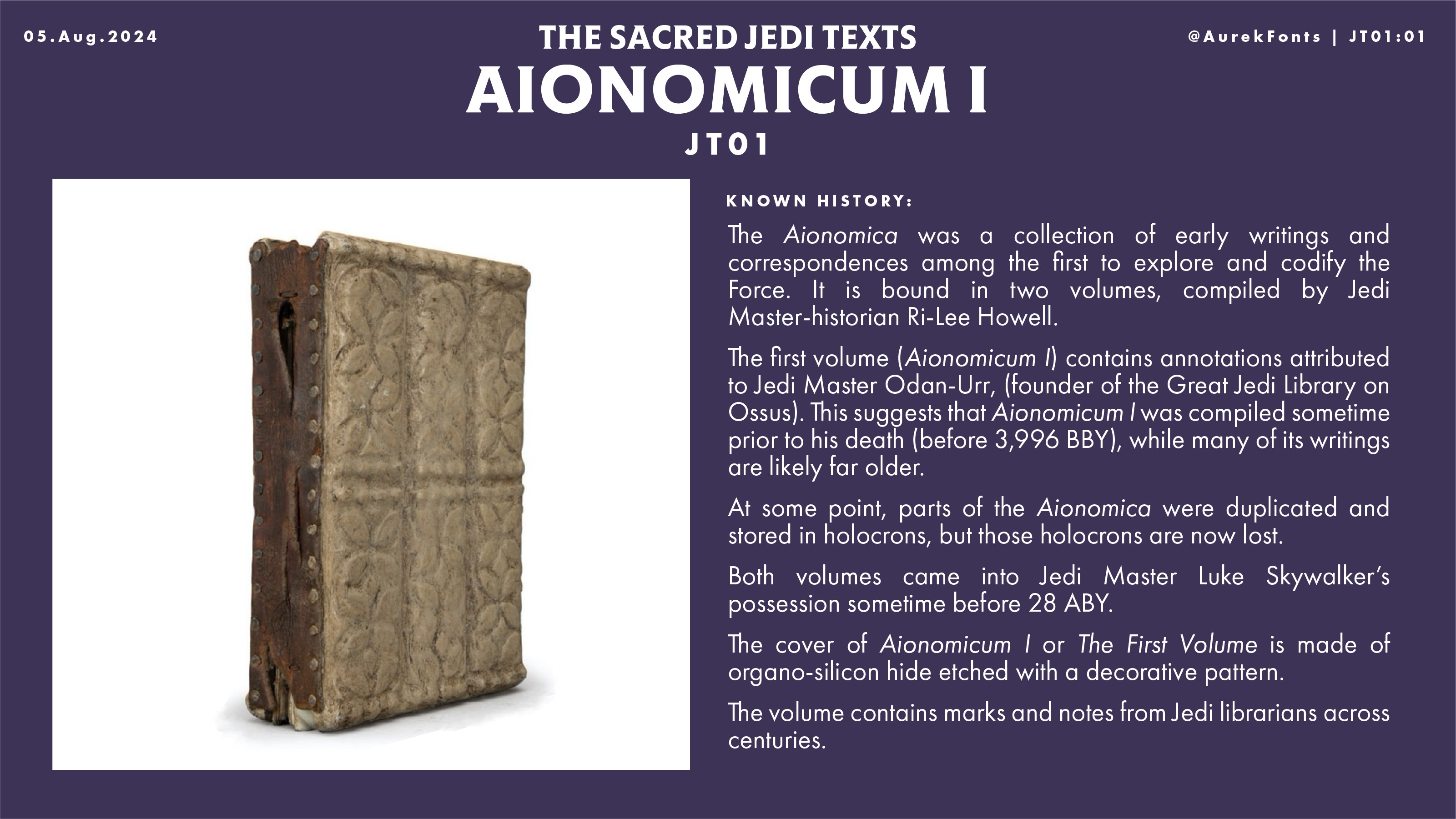
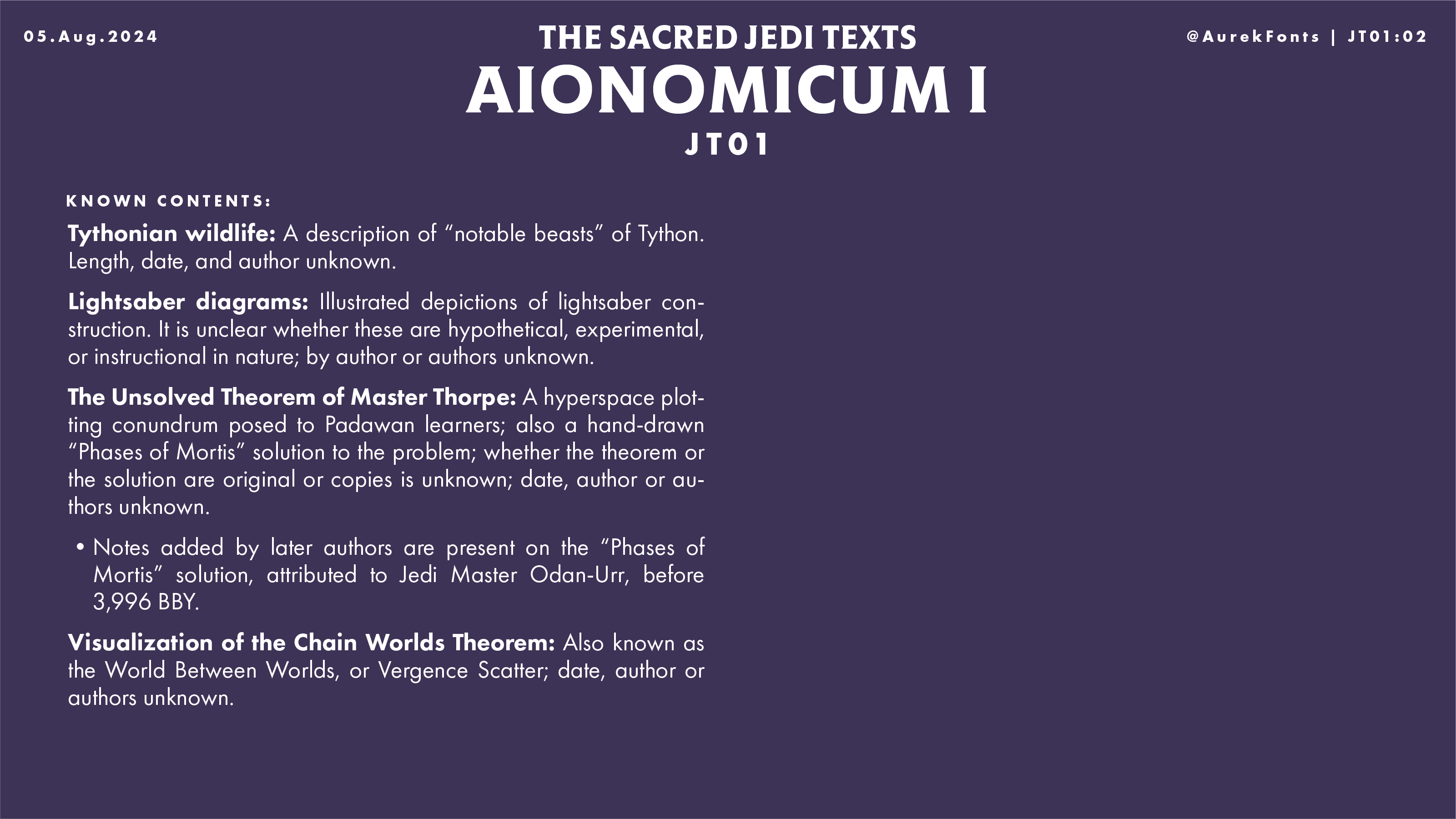

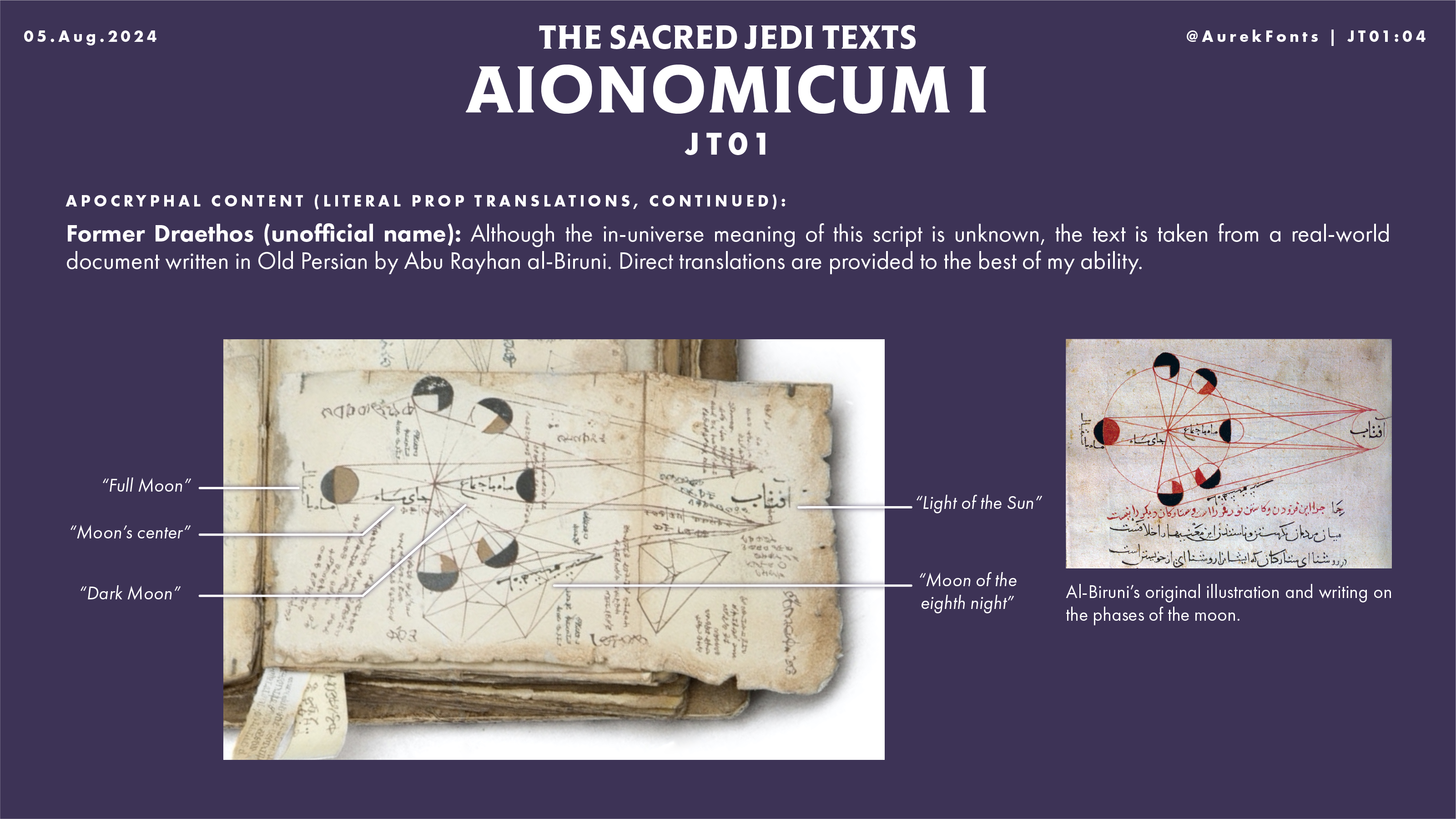
![The Sacred Jedi Texts. JT01: Aionomicum I, page 5.
Apocryphal Content (Literal Prop Translations, continued):
Protobesh: (See JT01: Aionomicum I, page 3.)
Burkean Cursive (unofficial name): Certain pages of Aionomicum I are written in a cursive script of unknown origin or meaning.
(An accompanying image shows another page of the Aionomica I; there are mathematical graphs, and strange shapes, as well as a tree-like graph pasted in; there is also a lot of text, some of which is obscured by the pasted-in graph.)
(Text labels give translations of the alien writing. They are transcribed here, with standardized spelling, and with repetition kept to a minimum, to avoid clutter in the alt text):
'Ignition process. Once the crystal is aligned, stability is critical. Once aligned, the crystal begins to glow once correct aligned, crystal fits into clamp. Crystal is most volatile at this stage.'
'And therefore illegal to trade. Pieces are often traded amongst the smugglers and black marketeers as a power source.'
'In the second phase of each star cycle, the Jedi [...] the chance to align their being with the Force.'
'The Force flows freely. This means nothing to me. The Force is all. The final chance to Force-align. Star phase three, entire crystal, two faceted side, lorem ipsum, spacebu, crystal will be divided into three pieces, is misaligned.' The Sacred Jedi Texts. JT01: Aionomicum I, page 5. Apocryphal Content (Literal Prop Translations, continued): Protobesh: (See JT01: Aionomicum I, page 3.) Burkean Cursive (unofficial name): Certain pages of Aionomicum I are written in a cursive script of unknown origin or meaning. (An accompanying image shows another page of the Aionomica I; there are mathematical graphs, and strange shapes, as well as a tree-like graph pasted in; there is also a lot of text, some of which is obscured by the pasted-in graph.) (Text labels give translations of the alien writing. They are transcribed here, with standardized spelling, and with repetition kept to a minimum, to avoid clutter in the alt text): 'Ignition process. Once the crystal is aligned, stability is critical. Once aligned, the crystal begins to glow once correct aligned, crystal fits into clamp. Crystal is most volatile at this stage.' 'And therefore illegal to trade. Pieces are often traded amongst the smugglers and black marketeers as a power source.' 'In the second phase of each star cycle, the Jedi [...] the chance to align their being with the Force.' 'The Force flows freely. This means nothing to me. The Force is all. The final chance to Force-align. Star phase three, entire crystal, two faceted side, lorem ipsum, spacebu, crystal will be divided into three pieces, is misaligned.'](./src/GuideToSacredJediTexts/JT01/JT01-05.png)
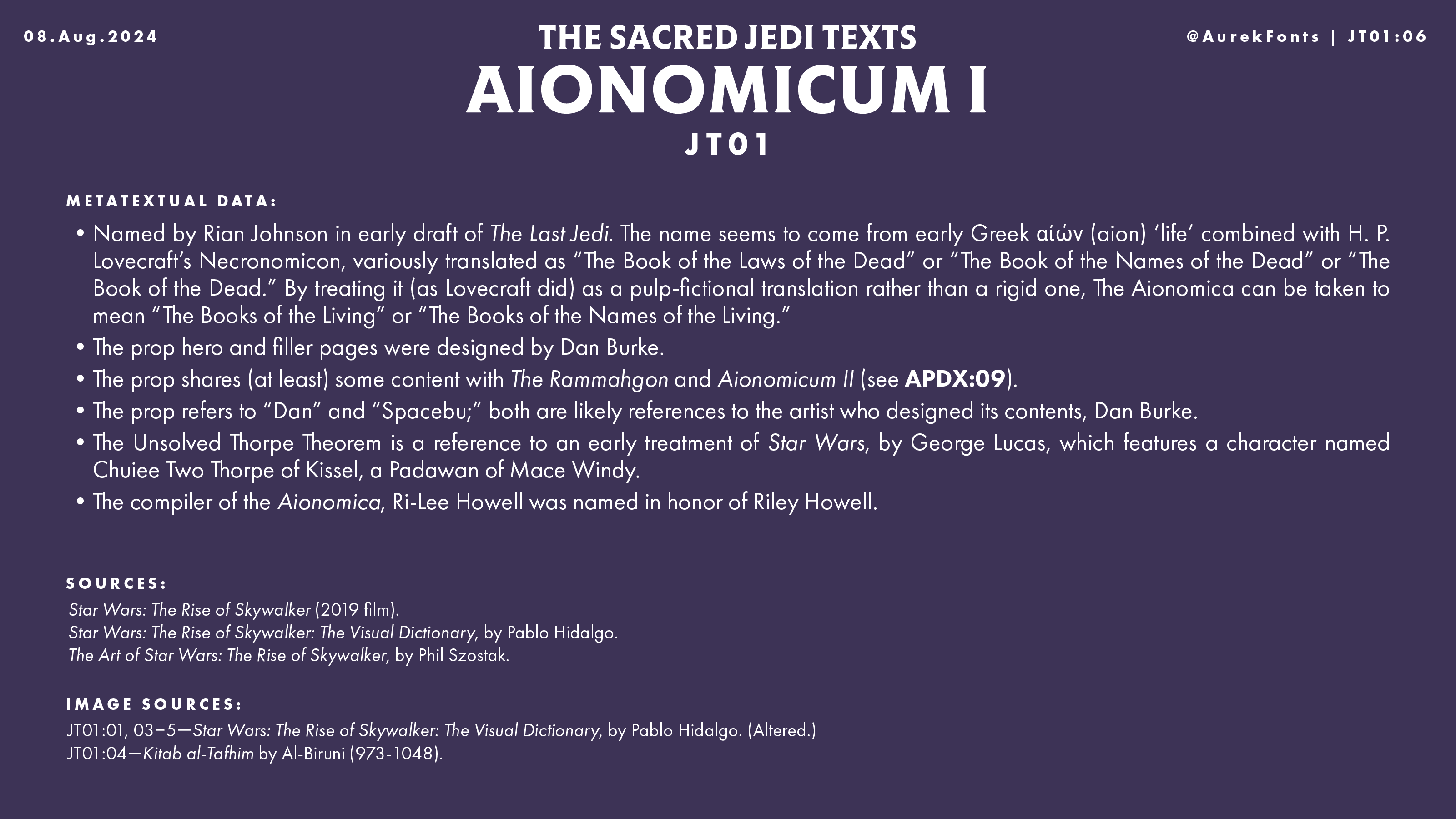
JT02
![The Sacred Jedi Texts. JT02: [Organic Spine], page 1.
(Detail of a screenshot from The Last Jedi, focusing on the second book from the left of the bookshelf. It has a rough spine seemingly woven or grown from green organic material.)
Known History:
JT02 came into Jedi Master Luke Skywalker's possession sometime before 28 ABY, and subsequently passed into Jedi Rey's possession.
The spine appears to be made of organic material woven or grown for this purpose.
Known Contents:
None.
Possible Identification:
JT02 could be either The Chronicles of Brus-bu (JTX1) or Poetics of a Jedi (JTX2), but only because neither can be definitively ruled out. The Sacred Jedi Texts. JT02: [Organic Spine], page 1. (Detail of a screenshot from The Last Jedi, focusing on the second book from the left of the bookshelf. It has a rough spine seemingly woven or grown from green organic material.) Known History: JT02 came into Jedi Master Luke Skywalker's possession sometime before 28 ABY, and subsequently passed into Jedi Rey's possession. The spine appears to be made of organic material woven or grown for this purpose. Known Contents: None. Possible Identification: JT02 could be either The Chronicles of Brus-bu (JTX1) or Poetics of a Jedi (JTX2), but only because neither can be definitively ruled out.](./src/GuideToSacredJediTexts/JT02/JT02-01.png)
![The Sacred Jedi Texts. JT02: [Organic Spine], page 2.
Metatextual Data:
Judging by the spine, the cover may be based on concept art by James Carson, which features Aurebesh on the cover, transliterated as 'Zeoht'.
(An accompanying image of the concept art in question, which similarly features a cover apparently grown from organic plant matter, emblazoned with a Rebel Starbird insignia and Aurebesh lettering.)
Sources:
Star Wars: The Last Jedi (2017 film).
The Art of Star Wars: The Rise of Skywalker, by Phil Szostak.
Image Sources:
Page 1: Star Wars: The Last Jedi (2017 film).
Page 2: The Art of Star Wars: The Rise of Skywalker, by Phil Szostak. The Sacred Jedi Texts. JT02: [Organic Spine], page 2. Metatextual Data: Judging by the spine, the cover may be based on concept art by James Carson, which features Aurebesh on the cover, transliterated as 'Zeoht'. (An accompanying image of the concept art in question, which similarly features a cover apparently grown from organic plant matter, emblazoned with a Rebel Starbird insignia and Aurebesh lettering.) Sources: Star Wars: The Last Jedi (2017 film). The Art of Star Wars: The Rise of Skywalker, by Phil Szostak. Image Sources: Page 1: Star Wars: The Last Jedi (2017 film). Page 2: The Art of Star Wars: The Rise of Skywalker, by Phil Szostak.](./src/GuideToSacredJediTexts/JT02/JT02-02.png)
JT03
![The Sacred Jedi Texts. JT03: [Geometric Spine], page 1.
(Composite illustration of JT03, combining elements from a screenshot from The Last Jedi, a still from The Rise of Skywalker: The Visual Dictionary, and hand sketched to suggest the scale of the fragmentary image. Only the spine and a small portion of the cover are clearly seen. The spine features a winding geometric pattern engraved on light material, while the portion of front cover we can see is made of a darker material and carved with geometric reliefs.)
Known History:
This book came into Jedi Master Luke Skywalker's possession sometime before 28 ABY, and later fell into the possession of Jedi Rey. The protocol droid C-3PO was able to read from the book.
The spine features a winding geometric pattern engraved on light material, while the front and back covers are made of a darker material. At least one cover is carved with geometric reliefs, and the corners have metal corner protectors. The spine is bound together with decorative cordage. The Sacred Jedi Texts. JT03: [Geometric Spine], page 1. (Composite illustration of JT03, combining elements from a screenshot from The Last Jedi, a still from The Rise of Skywalker: The Visual Dictionary, and hand sketched to suggest the scale of the fragmentary image. Only the spine and a small portion of the cover are clearly seen. The spine features a winding geometric pattern engraved on light material, while the portion of front cover we can see is made of a darker material and carved with geometric reliefs.) Known History: This book came into Jedi Master Luke Skywalker's possession sometime before 28 ABY, and later fell into the possession of Jedi Rey. The protocol droid C-3PO was able to read from the book.
The spine features a winding geometric pattern engraved on light material, while the front and back covers are made of a darker material. At least one cover is carved with geometric reliefs, and the corners have metal corner protectors. The spine is bound together with decorative cordage.](./src/GuideToSacredJediTexts/JT03/JT03-01.png)
![The Sacred Jedi Texts. JT03: [Organic Spine], page 2.
Known Contents:
The Jedi and the Force: C-3PO is known to have translated at least one brief passage of the book for Rey, as she began her study of the texts: 'The Force is the light, the Force is the dark. The Jedi choose the light, for all it reveals.'
Possible Identification:
It is possible that JT03 is either The Chronicles of Brus-bu (JTX1) or Poetics of a Jedi (JTX2). Judging by the opening poetical refrain read by C-3PO, and the description of Poetics as being 'a thin folio' that feels like a slightly more probable identification.
(Detail of a comic book panel from Star Wars: Poe Dameron, #28 of C-3PO reading from JT03.)
Sources:
Star Wars: The Last Jedi (2017 film).
Star Wars: The Rise of Skywalker (2019 film).
Star Wars: Poe Dameron, #28 (comic).
Star Wars: The Rise of Skywalker: A Junior Novel, by Michael Kogge.
Image Sources:
Page 1: Star Wars: The Rise of Skywalker: The Visual Dictionary, by Pablo Hidalgo. (Composite.)
Page 1: Star Wars: The Last Jedi (2017 film). (Composite.)
Page 2: Star Wars: Poe Dameron, #28 (comic). The Sacred Jedi Texts. JT03: [Organic Spine], page 2. Known Contents: The Jedi and the Force: C-3PO is known to have translated at least one brief passage of the book for Rey, as she began her study of the texts: 'The Force is the light, the Force is the dark. The Jedi choose the light, for all it reveals.' Possible Identification: It is possible that JT03 is either The Chronicles of Brus-bu (JTX1) or Poetics of a Jedi (JTX2). Judging by the opening poetical refrain read by C-3PO, and the description of Poetics as being 'a thin folio' that feels like a slightly more probable identification. Sources: Star Wars: The Last Jedi (2017 film). Star Wars: The Rise of Skywalker (2019 film). Star Wars: Poe Dameron, #28 (comic). Star Wars: The Rise of Skywalker: A Junior Novel, by Michael Kogge. Image Sources: Page 1: Star Wars: The Rise of Skywalker: The Visual Dictionary, by Pablo Hidalgo. (Composite.) Page 1: Star Wars: The Last Jedi (2017 film). (Composite.) Page 2: Star Wars: Poe Dameron, #28 (comic).](./src/GuideToSacredJediTexts/JT03/JT03-02.png)
JT04
![The Sacred Jedi Texts. JT04: [Marabesh Spine], page 1.
(Detail of a screenshot from The Last Jedi, focusing on the fourth book from the left of the bookshelf. It has a smooth spine made of wood or bone, engraved with arcing circular symbols.)
Known History:
JT04 came into Jedi Master Luke Skywalker's possession sometime before 28 ABY, and subsequently passed into Jedi Rey's possession.
The spine is decorated with glyphs or symbols in an unknown script, referred to herein as Marabesh (see Appendices, page 7).
Known Contents:
None.
Possible Identification:
JT02 could be either The Chronicles of Brus-bu (JTX1) or Poetics of a Jedi (JTX2), but only because neither can be definitively ruled out.
Sources:
Star Wars: The Last Jedi (2017 film).
Image Sources:
Page 1: Star Wars: The Last Jedi (2017 film). The Sacred Jedi Texts. JT04: [Marabesh Spine], page 1. (Detail of a screenshot from The Last Jedi, focusing on the fourth book from the left of the bookshelf. It has a smooth spine made of wood or bone, engraved with arcing circular symbols.) Known History: JT04 came into Jedi Master Luke Skywalker's possession sometime before 28 ABY, and subsequently passed into Jedi Rey's possession. The spine is decorated with glyphs or symbols in an unknown script, referred to herein as Marabesh (see Appendices, page 7). Known Contents: None. Possible Identification: JT02 could be either The Chronicles of Brus-bu (JTX1) or Poetics of a Jedi (JTX2), but only because neither can be definitively ruled out. Sources: Star Wars: The Last Jedi (2017 film). Image Sources: Page 1: Star Wars: The Last Jedi (2017 film).](./src/GuideToSacredJediTexts/JT04/JT04-01.png)
JT05
![The Sacred Jedi Texts. JT05: [TLJ Hero], page 1.
(A photograph of JT05: A codex with a reddish-brown cover with thick, raised markings. The front cover is made of three hinged panels connected together with cord. The cover is attached to the spine in a similar manner. The book is angled as if set on a table.)
Known and Extrapolated History:
Little is known about the history of JT05 before Luke Skywalker discovered it in the arms of a skeleton within the Living Sea of Gazian in 3 or 4 ABY.
The front cover is made up of three hinged vertical panels. The first panel (counting from the spine) is decorated with the word 'JEDI,' written in the relatively modern Aurebesh; the second is decorated with a geometric pattern that does not appear to be linguistic in nature; the third panel contains several symbols of unknown origin or meaning, which we will call Serianan Runes (unofficial name).
The pages within are written in an ancient calligraphic script (see JT05: [TLJ Hero], page 3) and feature extensive gold illumination, both in text and in decoration. Most of the pages show signs of extensive damage.
Neither Aurebesh nor the unknown symbols on the cover match the language the book itself is written in, suggesting that this is not the original cover. The Sacred Jedi Texts. JT05: [TLJ Hero], page 1. (A photograph of JT05: A codex with a reddish-brown cover with thick, raised markings. The front cover is made of three hinged panels connected together with cord. The cover is attached to the spine in a similar manner. The book is angled as if set on a table.) Known and Extrapolated History: Little is known about the history of JT05 before Luke Skywalker discovered it in the arms of a skeleton within the Living Sea of Gazian in 3 or 4 ABY. The front cover is made up of three hinged vertical panels. The first panel (counting from the spine) is decorated with the word 'JEDI,' written in the relatively modern Aurebesh; the second is decorated with a geometric pattern that does not appear to be linguistic in nature; the third panel contains several symbols of unknown origin or meaning, which we will call Serianan Runes (unofficial name). The pages within are written in an ancient calligraphic script (see JT05: [TLJ Hero], page 3) and feature extensive gold illumination, both in text and in decoration. Most of the pages show signs of extensive damage. Neither Aurebesh nor the unknown symbols on the cover match the language the book itself is written in, suggesting that this is not the original cover.](./src/GuideToSacredJediTexts/JT05/JT05-01.png)
![The Sacred Jedi Texts. JT05: [TLJ Hero], page 2.
Known Contents:
The Crest of the Jedi Order: The first page of JT05 features what is perhaps the earliest extant depiction of 'the winged blade of light' or 'the living sunrise' ideogram that would later become the official Crest of the Jedi Order.
(An accompanying photograph of JT05 open to its first page: In the center of the page is the Crest of the Jedi Order, in blue and gold illumination; it is surrounded by writing in an alien language; the page has significant losses, with the upper left and lower right corners missing completely, and much of the inks worn off besides; the pages are blackened from the edges running inward, and appear brittle.)
The use of such a potent religious symbol on its opening page, along with the presentation of the contents in such a uniformly illuminated style and its lack of marginal annotations, suggests that this volume (in contrast to composite works such as the Aionomica, which were deemed sacred only after their writing) was from its very conception intended to be a sacred work.
Planetary phase diagrams: The most prominent images associated with JT05 are its diagrams of planetary phases. It is unclear however what planets they refer to, if they are meant to be taken literally at all.
Philosophy on, and color illustrations of, Kyber crystals: Tells how young Jedi would go to Ilum to find their own Kyber crystals. Choosing a crystal and building a lightsaber was a rite of passage. The Sacred Jedi Texts. JT05: [TLJ Hero], page 2. Known Contents: The Crest of the Jedi Order: The first page of JT05 features what is perhaps the earliest extant depiction of 'the winged blade of light' or 'the living sunrise' ideogram that would later become the official Crest of the Jedi Order. (An accompanying photograph of JT05 open to its first page: In the center of the page is the Crest of the Jedi Order, in blue and gold illumination; it is surrounded by writing in an alien language; the page has significant losses, with the upper left and lower right corners missing completely, and much of the inks worn off besides; the pages are blackened from the edges running inward, and appear brittle.) The use of such a potent religious symbol on its opening page, along with the presentation of the contents in such a uniformly illuminated style and its lack of marginal annotations, suggests that this volume (in contrast to composite works such as the Aionomica, which were deemed sacred only after their writing) was from its very conception intended to be a sacred work. Planetary phase diagrams: The most prominent images associated with JT05 are its diagrams of planetary phases. It is unclear however what planets they refer to, if they are meant to be taken literally at all. Philosophy on, and color illustrations of, Kyber crystals: Tells how young Jedi would go to Ilum to find their own Kyber crystals. Choosing a crystal and building a lightsaber was a rite of passage.](./src/GuideToSacredJediTexts/JT05/JT05-02.png)
![The Sacred Jedi Texts. JT05: [TLJ Hero], page 3.
Apocryphal Content (Literal prop Transliterations):
Kitisakkullian (unofficial name): JT05 is written in a calligraphic script of unknown origin or meaning, originally drawn by concept artist Chris Kitisakkul. Unlike other writing systems with that possess one-to-one correspondence with the Latin Alphabet, this one does not. We will therefore interpret it as a 35-glyph syllabary (see Appendices, page 4) and provide a transcription (rather than a translation) of the six known pages.
(An accompanying concept art image of page 1 of JT05: The Crest of the Jedi Order emblazons the lower part of the page, while the upper third is covered in illuminated text written in a variety of inks: primarily dark brown, red, blue, and gold; it appears to have been written with a broad-nibbed quill or pen, with wide spacing between individual letters.)
(To the right of the image is a transcription of its contents, laid out in the same arrangement as the contents of the original page. Rather than include all of the alien text verbatim, cluttering the alt-text, the first line of each page will be provided. Page 1: 'Kur hannapuku shina nu Sha ha rmu...') The Sacred Jedi Texts. JT05: [TLJ Hero], page 3. Apocryphal Content (Literal prop Transliterations): Kitisakkullian (unofficial name): JT05 is written in a calligraphic script of unknown origin or meaning, originally drawn by concept artist Chris Kitisakkul. Unlike other writing systems with that possess one-to-one correspondence with the Latin Alphabet, this one does not. We will therefore interpret it as a 35-glyph syllabary (see Appendices, page 4) and provide a transcription (rather than a translation) of the six known pages. (An accompanying concept art image of page 1 of JT05: The Crest of the Jedi Order emblazons the lower part of the page, while the upper third is covered in illuminated text written in a variety of inks: primarily dark brown, red, blue, and gold; it appears to have been written with a broad-nibbed quill or pen, with wide spacing between individual letters.) (To the right of the image is a transcription of its contents, laid out in the same arrangement as the contents of the original page. Rather than include all of the alien text verbatim, cluttering the alt-text, the first line of each page will be provided. Page 1: 'Kur hannapuku shina nu Sha ha rmu...')](./src/GuideToSacredJediTexts/JT05/JT05-03.png)
![The Sacred Jedi Texts. JT05: [TLJ Hero], page 4.
Apocryphal Content (Literal prop Transliterations, continued):
Kitisakkullian: (see JT05: [TLJ Hero], page 3).
(An accompanying concept art image of page 2 of JT05: Circles intersected by arcs are inked in blue and gold. Text written in brown and red runs from the top of the page, in between these planetary figures, to the bottom gold geometric borders run on the top and bottom margins.)
(To the right of the image is a transcription of its contents, laid out in the same arrangement as the contents of the original page. Rather than include all of the alien text verbatim, cluttering the alt-text, the first line of each page will be provided. Page 2: 'Mumatushu shina hurimaha...') The Sacred Jedi Texts. JT05: [TLJ Hero], page 4. Apocryphal Content (Literal prop Transliterations, continued): Kitisakkullian: (see JT05: [TLJ Hero], page 3). (An accompanying concept art image of page 2 of JT05: Circles intersected by arcs are inked in blue and gold. Text written in brown and red runs from the top of the page, in between these planetary figures, to the bottom gold geometric borders run on the top and bottom margins.) (To the right of the image is a transcription of its contents, laid out in the same arrangement as the contents of the original page. Rather than include all of the alien text verbatim, cluttering the alt-text, the first line of each page will be provided. Page 2: 'Mumatushu shina hurimaha...')](./src/GuideToSacredJediTexts/JT05/JT05-04.png)
![The Sacred Jedi Texts. JT05: [TLJ Hero], page 5.
Apocryphal Content (Literal prop Transliterations, continued):
Kitisakkullian: (see JT05: [TLJ Hero], page 3).
(An accompanying concept art image of page 3 of JT05: A large blue and gold circle stands out in the upper right; the blue half of the circle contains three crescents moving from thin to thick from left to right; in the bottom left is a blue elipse containing more moon-phase diagrams: six crescents around the outside and a solid gold circle in the middle; text runs from the top of the page to the bottom, between the celestial diagrams; some letters are illuminated in gold and blue, while geometric borders subdivide the text.)
(To the right of the image is a transcription of its contents, laid out in the same arrangement as the contents of the original page. Rather than include all of the alien text verbatim, cluttering the alt-text, the first line of each page will be provided. Page 3: 'Hajina su sahirunu...') The Sacred Jedi Texts. JT05: [TLJ Hero], page 5. Apocryphal Content (Literal prop Transliterations, continued): Kitisakkullian: (see JT05: [TLJ Hero], page 3). (An accompanying concept art image of page 3 of JT05: A large blue and gold circle stands out in the upper right; the blue half of the circle contains three crescents moving from thin to thick from left to right; in the bottom left is a blue elipse containing more moon-phase diagrams: six crescents around the outside and a solid gold circle in the middle; text runs from the top of the page to the bottom, between the celestial diagrams; some letters are illuminated in gold and blue, while geometric borders subdivide the text.) (To the right of the image is a transcription of its contents, laid out in the same arrangement as the contents of the original page. Rather than include all of the alien text verbatim, cluttering the alt-text, the first line of each page will be provided. Page 3: 'Hajina su sahirunu...')](./src/GuideToSacredJediTexts/JT05/JT05-05.png)
![The Sacred Jedi Texts. JT05: [TLJ Hero], page 6.
Apocryphal Content (Literal Prop Transliterations, continued):
Kitisakkullian: (see JT05: [TLJ Hero], page 3).
(An accompanying concept art image of page 4 of JT05: Two diagrams made up of overlapping circles in blue and gold are set along the vertical cetner line of the page; on either side in brown and illuminated gold and blue ink, text fills in the space.)
(To the right of the image is a transcription of its contents, laid out in the same arrangement as the contents of the original page. Rather than include all of the alien text verbatim, cluttering the alt-text, the first line of each page will be provided. Page 4: 'Mumatushu shina ... su sahiru nu...') The Sacred Jedi Texts. JT05: [TLJ Hero], page 6. Apocryphal Content (Literal Prop Transliterations, continued): Kitisakkullian: (see JT05: [TLJ Hero], page 3). (An accompanying concept art image of page 4 of JT05: Two diagrams made up of overlapping circles in blue and gold are set along the vertical cetner line of the page; on either side in brown and illuminated gold and blue ink, text fills in the space.) (To the right of the image is a transcription of its contents, laid out in the same arrangement as the contents of the original page. Rather than include all of the alien text verbatim, cluttering the alt-text, the first line of each page will be provided. Page 4: 'Mumatushu shina ... su sahiru nu...')](./src/GuideToSacredJediTexts/JT05/JT05-06.png)
![The Sacred Jedi Texts. JT05: [TLJ Hero], page 7.
Apocryphal Content (Literal Prop Transliterations, continued):
Kitisakkullian: (see JT05: [TLJ Hero], page 3).
(An accompanying concept art image of page 5 of JT05: The page is subdivided by a grid of straight and u-shaped runs of text in brown and red; planetary circles cover several overlaps; more text runs within the negative spaces of this grid, some in brown and others in gold and blue; geometrice illuminated borders frame the upper and lower margins.)
(To the right of the image is a transcription of its contents, laid out in the same arrangement as the contents of the original page. Rather than include all of the alien text verbatim, cluttering the alt-text, the first line of each page will be provided. Page 5: 'Kur hiru nu puki...') The Sacred Jedi Texts. JT05: [TLJ Hero], page 7. Apocryphal Content (Literal Prop Transliterations, continued): Kitisakkullian: (see JT05: [TLJ Hero], page 3). (An accompanying concept art image of page 5 of JT05: The page is subdivided by a grid of straight and u-shaped runs of text in brown and red; planetary circles cover several overlaps; more text runs within the negative spaces of this grid, some in brown and others in gold and blue; geometrice illuminated borders frame the upper and lower margins.) (To the right of the image is a transcription of its contents, laid out in the same arrangement as the contents of the original page. Rather than include all of the alien text verbatim, cluttering the alt-text, the first line of each page will be provided. Page 5: 'Kur hiru nu puki...')](./src/GuideToSacredJediTexts/JT05/JT05-07.png)
![The Sacred Jedi Texts. JT05: [TLJ Hero], page 8.
Apocryphal Content (Literal Prop Transliterations, continued):
Kitisakkullian: (see JT05: [TLJ Hero], page 3).
(An accompanying concept art image of page 6 of JT05: The page is framed by a latticed border of red and gold; inside, text in brown and red and illuminated gold runs from the top to the bottom; in the middle is an illuminated phrase in gold on blue, written upside down; an additional line of text runs across the bottom of the page, outside the frame.)
(To the right of the image is a transcription of its contents, laid out in the same arrangement as the contents of the original page. Rather than include all of the alien text verbatim, cluttering the alt-text, the first line of each page will be provided. Page 6: 'Mumatushu shina hurimaha shinu...') The Sacred Jedi Texts. JT05: [TLJ Hero], page 8. Apocryphal Content (Literal Prop Transliterations, continued): Kitisakkullian: (see JT05: [TLJ Hero], page 3). (An accompanying concept art image of page 5 of JT05: The page is subdivided by a grid of straight and u-shaped runs of text in brown and red; planetary circles cover several overlaps; more text runs within the negative spaces of this grid, some in brown and others in gold and blue; geometrice illuminated borders frame the upper and lower margins.) (To the right of the image is a transcription of its contents, laid out in the same arrangement as the contents of the original page. Rather than include all of the alien text verbatim, cluttering the alt-text, the first line of each page will be provided. Page 6: 'Kur hiru nu puki...')](./src/GuideToSacredJediTexts/JT05/JT05-08.png)
![The Sacred Jedi Texts. JT05: [TLJ Hero], page 9.
A Final Mystery (Known and Extrapolated History, continued from JT05, page 1):
By 35 ABY, some pages (including Page 4) of JT05 appear to have been removed from their binding and relocated to another volume of Luke's library, in a loose-leaf fashion. It is uncertain when this happened, or to which volume they were relocated. Based on the visual reference available to us, it is most likely JT02, (although it could aslo be JT07). Did Luke or Rey undo the binding on JT05? and why were these pages removed?
Possible Identification:
JT05 could be either of the named-but-unidentified Jedi Texts.
Both JT05 and The Chronicles of Brus-bu (JTX1) are known to have sections about lightsaber construction, though JT05 is notable for being more philosophical than practical on the matter.
It is possible that this is Poetics of a Jedi (JTX2). However, Poetics is described as a 'thin folio,' for which there are better candidates among the library. The Sacred Jedi Texts. JT05: [TLJ Hero], page 9. A Final Mystery (Known and Extrapolated History, continued from JT05, page 1): By 35 ABY, some pages (including Page 4) of JT05 appear to have been removed from their binding and relocated to another volume of Luke's library, in a loose-leaf fashion. It is uncertain when this happened, or to which volume they were relocated. Based on the visual reference available to us, it is most likely JT02, (although it could aslo be JT07). Did Luke or Rey undo the binding on JT05? and why were these pages removed? Possible Identification: JT05 could be either of the named-but-unidentified Jedi Texts. Both JT05 and The Chronicles of Brus-bu (JTX1) are known to have sections about lightsaber construction, though JT05 is notable for being more philosophical than practical on the matter. It is possible that this is Poetics of a Jedi (JTX2). However, Poetics is described as a 'thin folio,' for which there are better candidates among the library.](./src/GuideToSacredJediTexts/JT05/JT05-09.png)
![The Sacred Jedi Texts. JT05: [TLJ Hero], page 10.
Metatextual Data:
The cover is closely based upon concept art by James Carson.
(Said piece of concept art is shown. It depicts a book with a wood cover made up of three hinged vertical segments, with writing in alien scripts running down each panel; the spine however is bear and exposes the threads used for binding the volume together.)
The interior pages were designed by Chris Kitisakkul.
At least three copies of JT05 were created for The Last Jedi, (see The Director and the Jedi, around the 56 minute mark).
Sources:
Star Wars: The Last Jedi (2017 film).
The Art of Star Wars: The Last Jedi, by Phil Szostak.
Inside the Lucasfilm Archive: The Jedi Texts, on starwars.com; by Kristin Baver.
Star Wars: The Rise of Skywalker: The Visual Dictionary, by Pablo Hidalgo.
Star Wars (2020) #20, #34 (comics), by Charles Soule.
Image Sources:
Pages 1 and 2: Inside the Lucasfilm Archive: The Jedi Texts, on starwars.com. Prop photos by Kyle Kao; props displayed by Portia Fontes. (Altered.)
Pages 3 through 8: The Art of Star Wars: The Last Jedi, by Phil Szostak. (Altered.)
Page 9: Star Wars: The Rise of Skywalker: The Visual Dictionary, by Pablo Hidalgo.
Page 10: jamescarsondesign.com/star-wars-viii/ The Sacred Jedi Texts. JT05: [TLJ Hero], page 10. Metatextual Data: The cover is closely based upon concept art by James Carson. (Said piece of concept art is shown. It depicts a book with a wood cover made up of three hinged vertical segments, with writing in alien scripts running down each panel; the spine however is bear and exposes the threads used for binding the volume together.) The interior pages were designed by Chris Kitisakkul. At least three copies of JT05 were created for The Last Jedi, (see The Director and the Jedi, around the 56 minute mark). Sources: Star Wars: The Last Jedi (2017 film). The Art of Star Wars: The Last Jedi, by Phil Szostak. Inside the Lucasfilm Archive: The Jedi Texts, on starwars.com; by Kristin Baver. Star Wars: The Rise of Skywalker: The Visual Dictionary, by Pablo Hidalgo. Star Wars (2020) #20, #34 (comics), by Charles Soule. Image Sources: Pages 1 and 2: Inside the Lucasfilm Archive: The Jedi Texts, on starwars.com. Prop photos by Kyle Kao; props displayed by Portia Fontes. (Altered.) Pages 3 through 8: The Art of Star Wars: The Last Jedi, by Phil Szostak. (Altered.) Page 9: Star Wars: The Rise of Skywalker: The Visual Dictionary, by Pablo Hidalgo. Page 10: jamescarsondesign.com/star-wars-viii/](./src/GuideToSacredJediTexts/JT05/JT05-10.png)
JT06
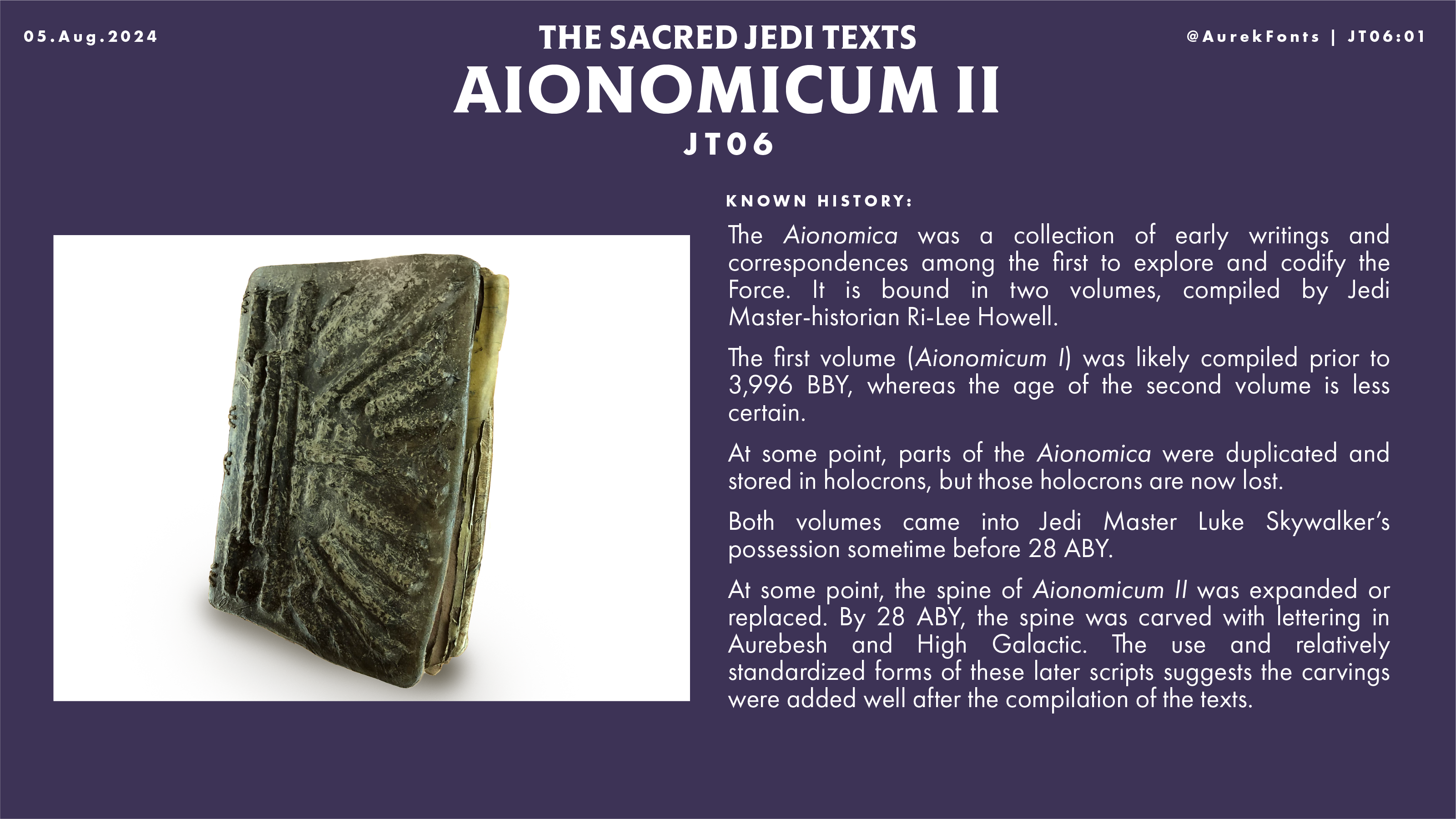
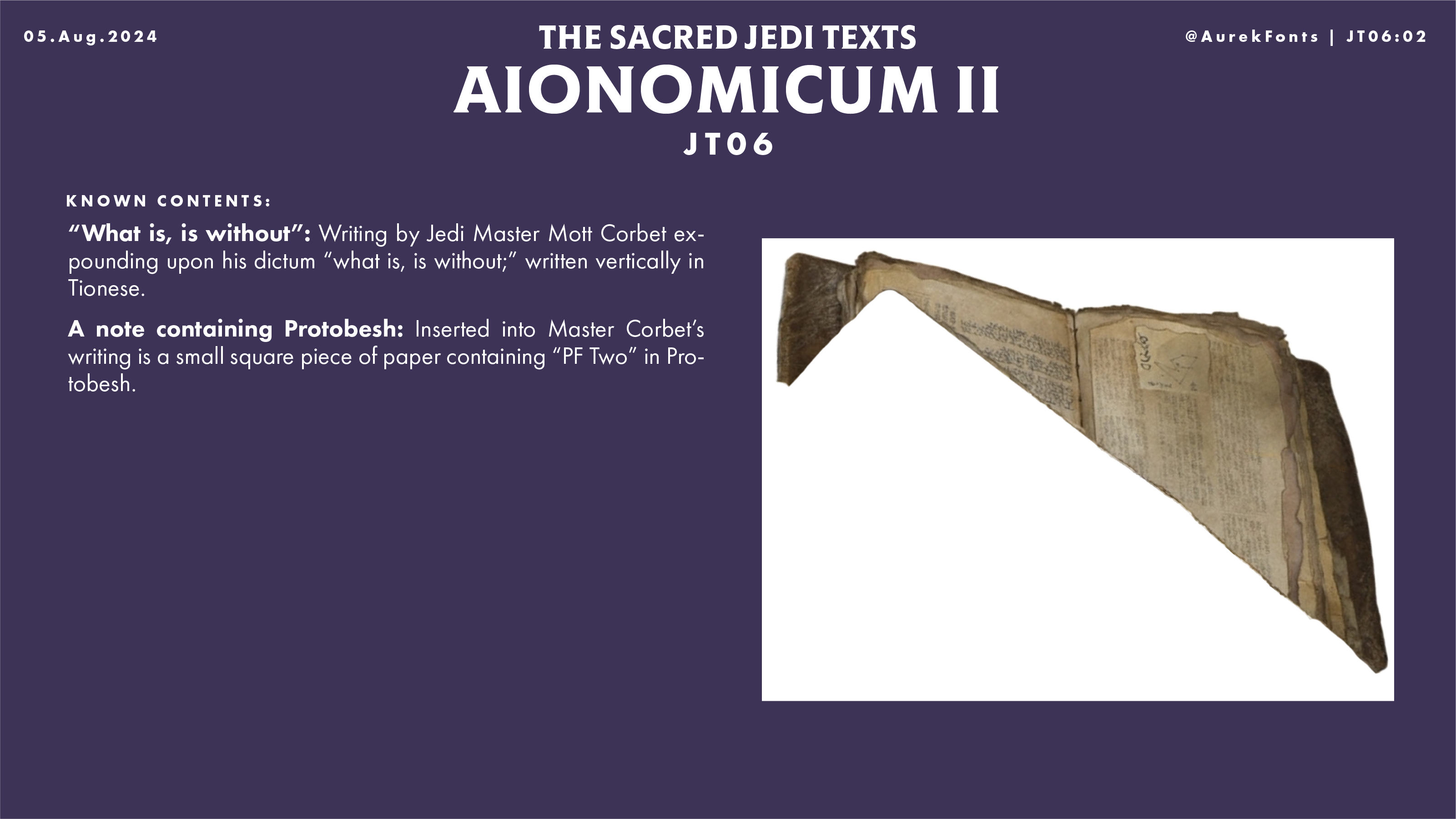
![The Sacred Jedi Texts. JT06: Aionomicum II, page 3.
Apocryphal Content (literal Prop Translations):
Aurebesh: A relatively modern alphabetical script, in common usage by 300 BBY. The alphabet has a nearly one-to-one correspondence with the Latin Alphabet, allowing us to translate the text exactly as it appears on screen.
High Galactic Alphabet: Another relatively modern alphabetical script, in occasional use by the fall of the Galactic Republic. This is the in-universe designation of the real-world Latin alphabet.
(An accompanying photograph of the spine of JT06, which is made of 4 pieces of bamboo-like wood, tied into two rows with some kind of cord; the pieces of the spine are decorated with very shallow carving, which is worn away with age; some of the carving depicts legible writing, which is labeled.)
(The labeled Aurebesh text reads: 'Martyn,' (twice), and 'Jedi [not legible].'
The labeled High Galactic text reads: 'MD,' drawn in the style of a set of initials.) The Sacred Jedi Texts. JT06: Aionomicum II, page 3. Apocryphal Content (literal Prop Translations): Aurebesh: A relatively modern alphabetical script, in common usage by 300 BBY. The alphabet has a nearly one-to-one correspondence with the Latin Alphabet, allowing us to translate the text exactly as it appears on screen. High Galactic Alphabet: Another relatively modern alphabetical script, in occasional use by the fall of the Galactic Republic. This is the in-universe designation of the real-world Latin alphabet. (An accompanying photograph of the spine of JT06, which is made of 4 pieces of bamboo-like wood, tied into two rows with some kind of cord; the pieces of the spine are decorated with very shallow carving, which is worn away with age; some of the carving depicts legible writing, which is labeled.) (The labeled Aurebesh text reads: 'Martyn,' (twice), and 'Jedi [not legible].'
The labeled High Galactic text reads: 'MD,' drawn in the style of a set of initials.)](./src/GuideToSacredJediTexts/JT06/JT06-03.png)
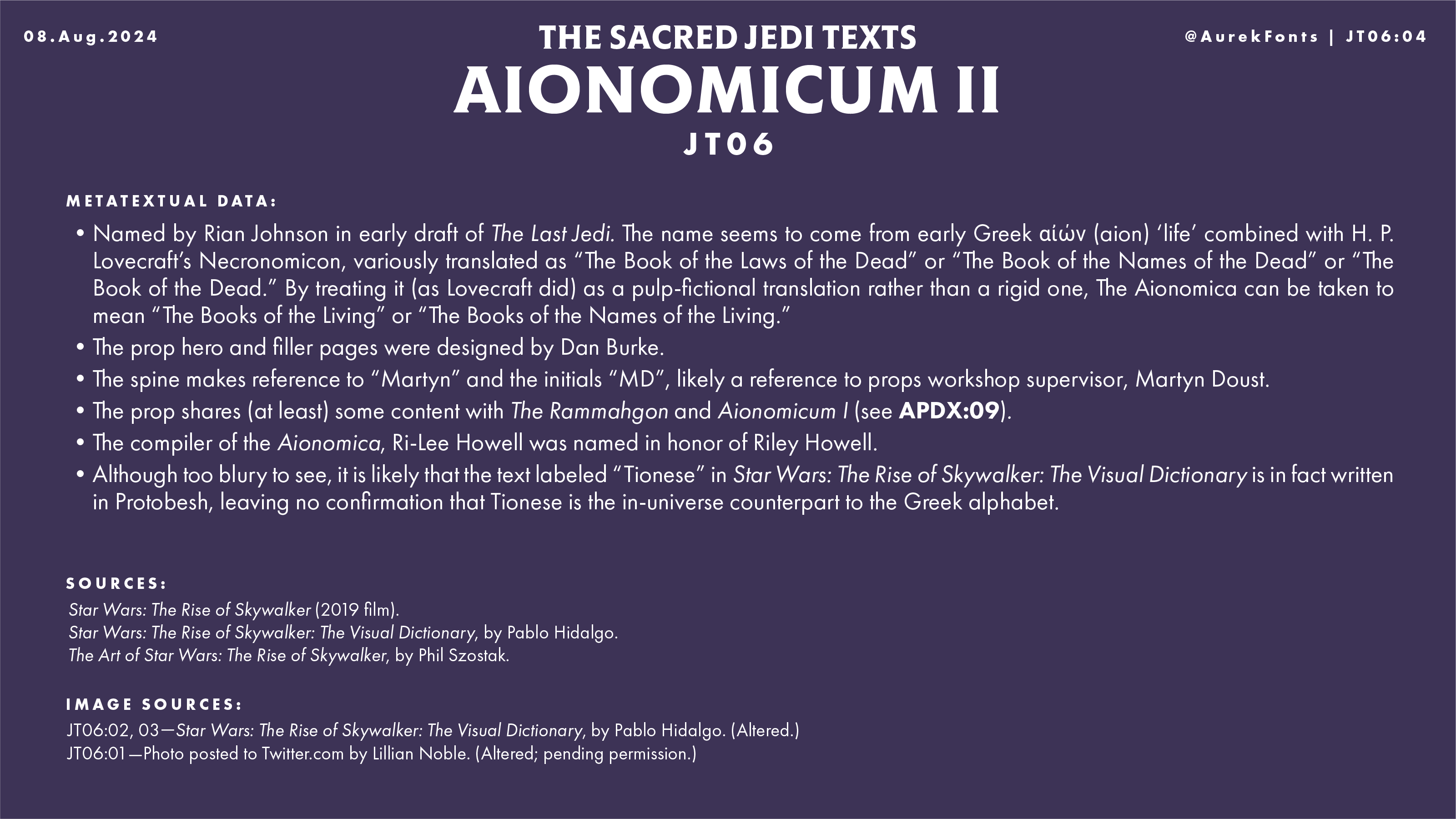
JT07
![The Sacred Jedi Texts. JT07: [Raised Star Map Cover], page 1.
(Composite reconstruction of JT07: Its front cover has lines and dots raised well off the surface, as if molded in clay; the raised marks resemble a star map; the edges of the cover are irregular; the spine is relatively uneventful by comparison, with slight insets and slightly obscure markings.)
Known History:
This text came into Jedi Master Luke Skywalker's possession sometime before 28 ABY and was later passed on to Jedi Rey's possession.
Its front and back covers appear to depict a raised star map, which is different on each face. The spine has some markings, but whether they are decorative or textual is not clear.
Known Contents:
None.
Possible Identification:
JT02 could be either The Chronicles of Brus-bu (JTX1) or Poetics of a Jedi (JTX2), but only because neither can be definitively ruled out.
Sources:
Star Wars: The Last Jedi (2017 film).
Star Wars: The Rise of Skywalker (2019 film).
Image Sources:
Page 1: Star Wars: The Rise of Skywalker (2019 film). (Composite.)
Page 1: Star Wars: The Last Jedi (2017 film). (Composite.) The Sacred Jedi Texts. JT07: [Raised Star Map Cover], page 1. (Composite reconstruction of JT07: Its front cover has lines and dots raised well off the surface, as if molded in clay; the raised marks resemble a star map; the edges of the cover are irregular; the spine is relatively uneventful by comparison, with slight insets and slightly obscure markings.) Known History: This text came into Jedi Master Luke Skywalker's possession sometime before 28 ABY and was later passed on to Jedi Rey's possession. Its front and back covers appear to depict a raised star map, which is different on each face. The spine has some markings, but whether they are decorative or textual is not clear. Known Contents: None. Possible Identification: JT02 could be either The Chronicles of Brus-bu (JTX1) or Poetics of a Jedi (JTX2), but only because neither can be definitively ruled out. Sources: Star Wars: The Last Jedi (2017 film). Star Wars: The Rise of Skywalker (2019 film). Image Sources: Page 1: Star Wars: The Rise of Skywalker (2019 film). (Composite.) Page 1: Star Wars: The Last Jedi (2017 film). (Composite.)](./src/GuideToSacredJediTexts/JT07/JT07-01.png)
JT08
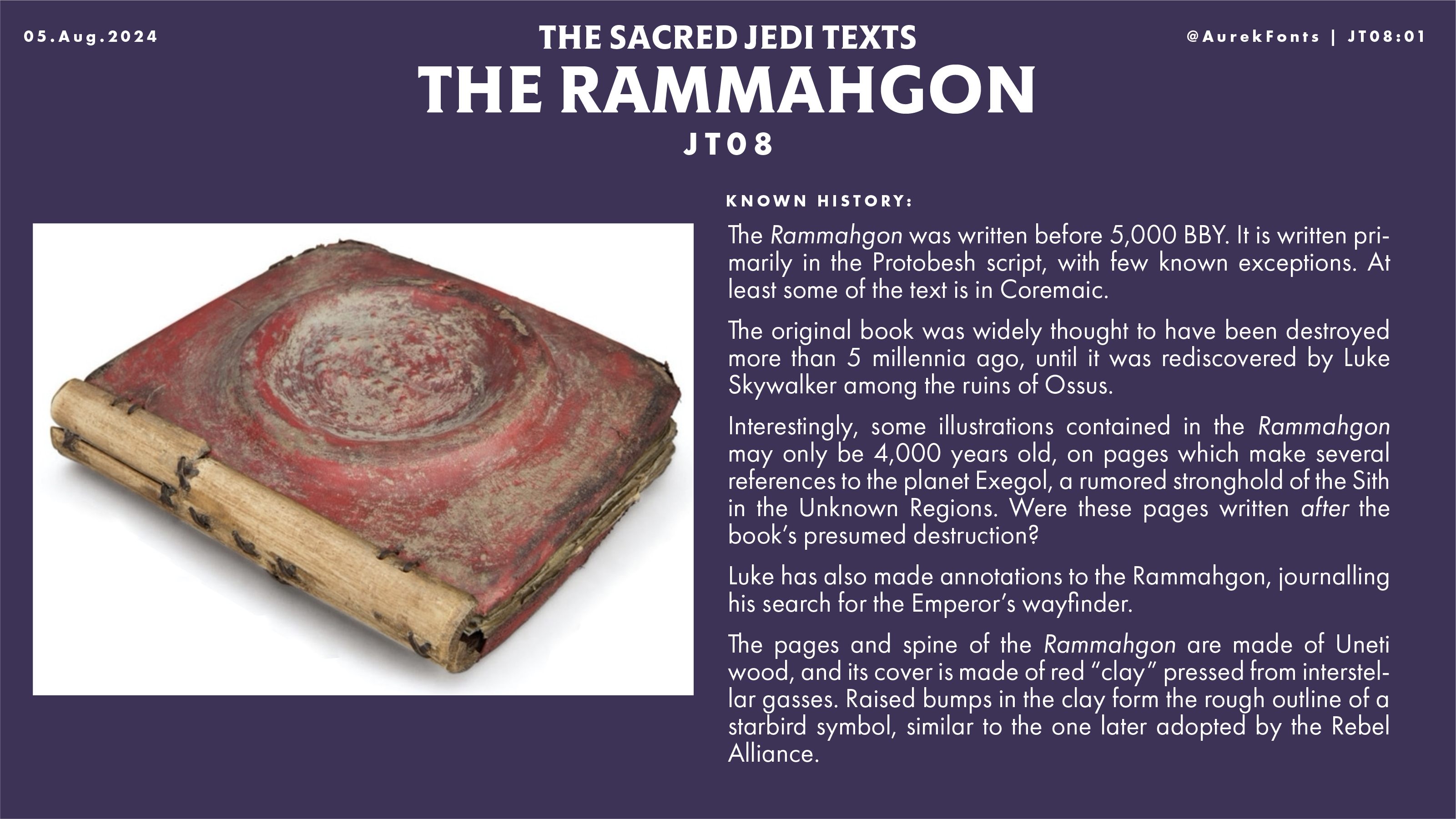
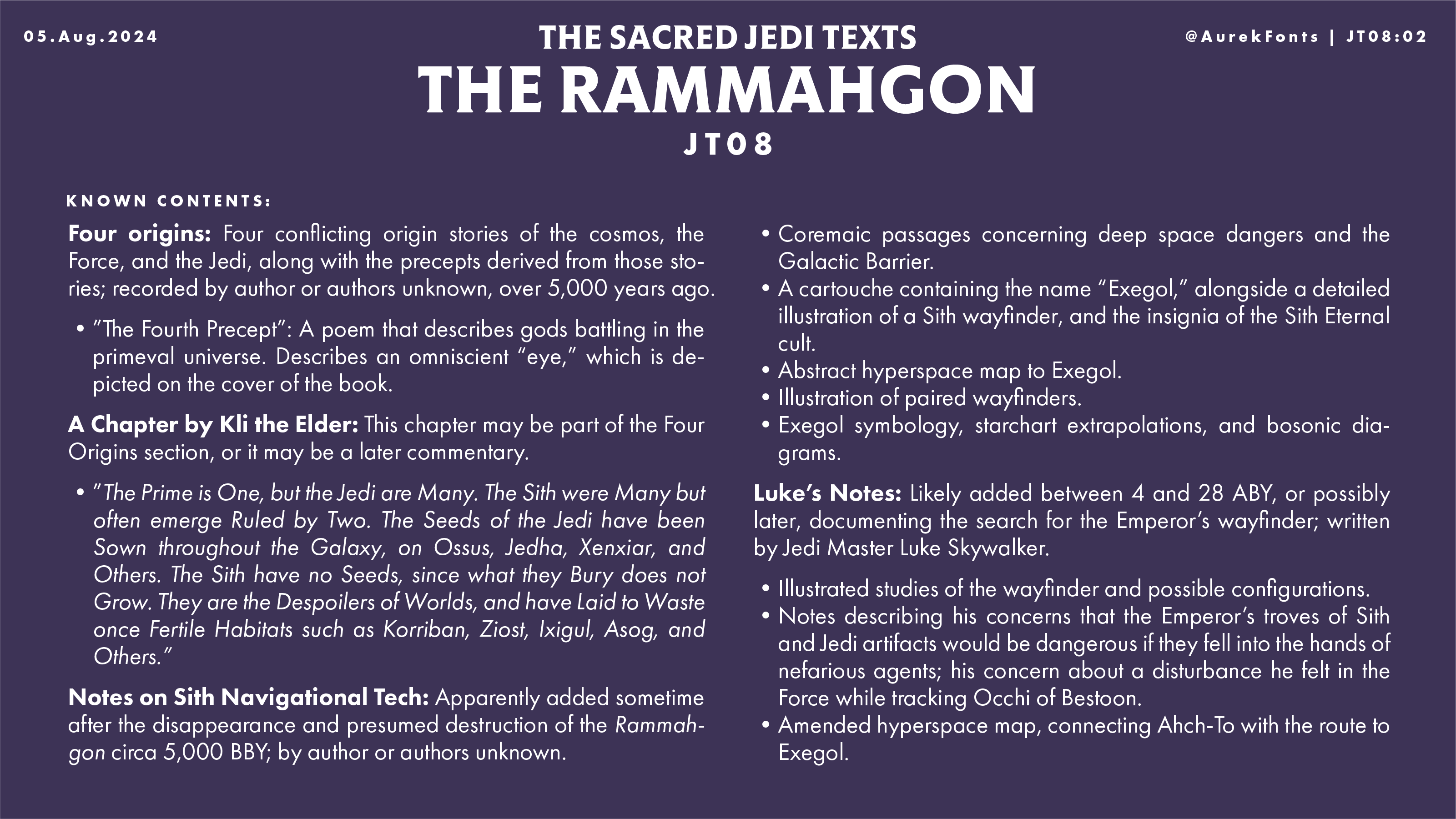
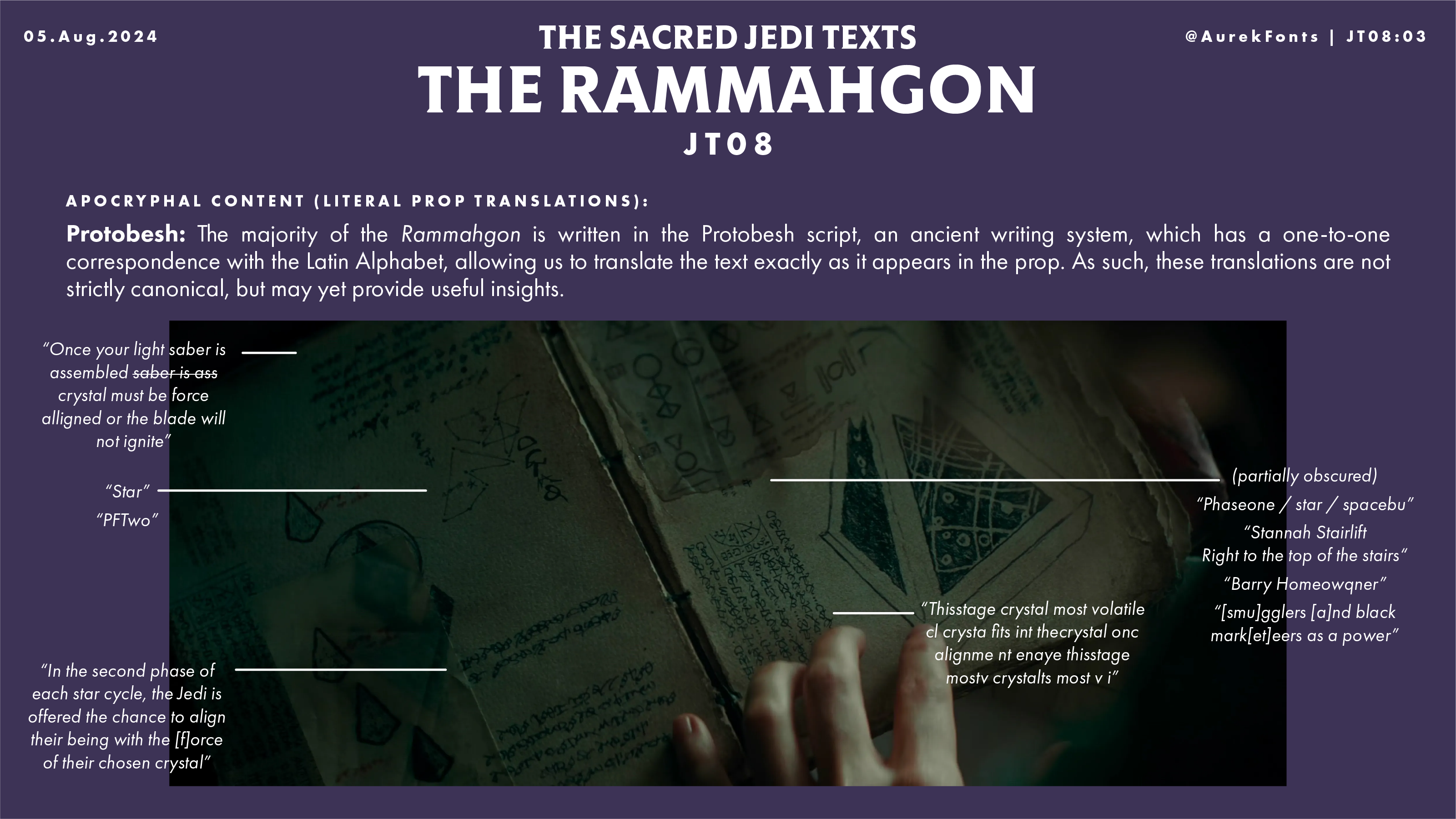
![The Sacred Jedi Texts. JT08: The Rammahgon, page 4.
Apocryphal Content (Literal Prop Translations, continued):
Protobesh: (See JT08, page 3.)
Tythonian Algebra (unofficial name): Some pages of the Rammahgon contain what appear to be mathematical symbols of an unknown origin or meaning, perhaps originally drawn by concept artist Dan Burke. We will interpret it as a base-25 numeric system.
(An accompanying screenshot from The Rise of Skywalker, of Rey reading from a page of The Rammahgon: There are long and short passages of text in multiple styles, and partial scraps of paper pasted in from various apparen sources.)
(This image is labeled with translations which range in intelligibility from complete thoughts, to seemingly random words, to pure gibberish. Rather than transcribing all of them in this alt text, a subset of the most meaningful notes has been selected, to avoid clutter (spelling has also been standardized)):
'(Protobesh) [C]entral alignment ... critical ignition process once aligned, the crystal...'
'(Tythonian Algebra) 2+3+2+1+9+10+6+18+14....' The Sacred Jedi Texts. JT08: The Rammahgon, page 4. Apocryphal Content (Literal Prop Translations, continued): Protobesh: (See JT08, page 3.) Tythonian Algebra (unofficial name): Some pages of the Rammahgon contain what appear to be mathematical symbols of an unknown origin or meaning, perhaps originally drawn by concept artist Dan Burke. We will interpret it as a base-25 numeric system. (An accompanying screenshot from The Rise of Skywalker, of Rey reading from a page of The Rammahgon: There are long and short passages of text in multiple styles, and partial scraps of paper pasted in from various apparen sources.) (This image is labeled with translations which range in intelligibility from complete thoughts, to seemingly random words, to pure gibberish. Rather than transcribing all of them in this alt text, a subset of the most meaningful notes has been selected, to avoid clutter (spelling has also been standardized)): '(Protobesh) [C]entral alignment ... critical ignition process once aligned, the crystal...' '(Tythonian Algebra) 2+3+2+1+9+10+6+18+14....'](./src/GuideToSacredJediTexts/JT08/JT08-04.png)
![The Sacred Jedi Texts. JT08: The Rammahgon, page 5.
Apocryphal Content (Literal Prop Translations, continued):
Protobesh: (See JT08, page 3.)
Tythonian Algebra: (See JT08, page 4.)
(An accompanying screenshot from The Rise of Skywalker, of Rey reading from a page of The Rammahgon: There are long and short passages of text in multiple styles, a diagram of a faceted crystal, and partial scraps of paper pasted in from various apparen sources.)
(This image is labeled with translations which range in intelligibility from complete thoughts, to seemingly random words, to pure gibberish. Rather than transcribing all of them in this alt text, a subset of the most meaningful notes has been selected, to avoid clutter (spelling has also been standardized)):
'(Protobesh) Split pieces can no be no longer used to channel the Force; failed pieces are highly... and therefore illegal to trade. Pieces are traded amongst the smugglers and black marketeers as a power source. [...] Although common is often and easily misaligned...'
'(Protobesh) The Force is strongest, the Force flows freely, the Force is all. This means nothing to me.'
'(Tythonian Algebra) 5 11 9 17 6 0 11 10 24' The Sacred Jedi Texts. JT08: The Rammahgon, page 5. Apocryphal Content (Literal Prop Translations, continued): Protobesh: (See JT08, page 3.) Tythonian Algebra: (See JT08, page 4.) (An accompanying screenshot from The Rise of Skywalker, of Rey reading from a page of The Rammahgon: There are long and short passages of text in multiple styles, a diagram of a faceted crystal, and partial scraps of paper pasted in from various apparen sources.) (This image is labeled with translations which range in intelligibility from complete thoughts, to seemingly random words, to pure gibberish. Rather than transcribing all of them in this alt text, a subset of the most meaningful notes has been selected, to avoid clutter (spelling has also been standardized)): '(Protobesh) Split pieces can no be no longer used to channel the Force; failed pieces are highly... and therefore illegal to trade. Pieces are traded amongst the smugglers and black marketeers as a power source. [...] Although common is often and easily misaligned...' '(Protobesh) The Force is strongest, the Force flows freely, the Force is all. This means nothing to me.' '(Tythonian Algebra) 5 11 9 17 6 0 11 10 24'](./src/GuideToSacredJediTexts/JT08/JT08-05.png)
![The Sacred Jedi Texts. JT08: The Rammahgon, page 6.
Apocryphal Content (Literal Prop Translations, continued):
Protobesh: (See JT08, page 3.)
Tythonian Algebra: (See JT08, page 4.)
Burkean Cursive (unofficial name): Certain pages of the Rammahgon are written in a cursive script of unknown origin or meaning, perhaps originally drawn by concept artist Dan Burke.
(An accompanying photo of an inner page of the Rammahgon: There are large connected tree-like graphs, notes written in differing styles, and two large illustrations of pyramidal Sith Wayfinders.)
(This image is labeled with translations which range in intelligibility from complete thoughts, to seemingly random words, to pure gibberish. Rather than transcribing all of them in this alt text, a subset of the most meaningful notes has been selected, to avoid clutter (spelling has also been standardized)):
'(Protobesh) Phase one. Star. Spacebu. And therefore illegal to trade. Crystal pieces traded amongst the [smu]gglers and black mar[k]eterrs as a power source.' The Sacred Jedi Texts. JT08: The Rammahgon, page 6. Apocryphal Content (Literal Prop Translations, continued): Protobesh: (See JT08, page 3.) Tythonian Algebra: (See JT08, page 4.) Burkean Cursive (unofficial name): Certain pages of the Rammahgon are written in a cursive script of unknown origin or meaning, perhaps originally drawn by concept artist Dan Burke. (An accompanying photo of an inner page of the Rammahgon: There are large connected tree-like graphs, notes written in differing styles, and two large illustrations of pyramidal Sith Wayfinders.) (This image is labeled with translations which range in intelligibility from complete thoughts, to seemingly random words, to pure gibberish. Rather than transcribing all of them in this alt text, a subset of the most meaningful notes has been selected, to avoid clutter (spelling has also been standardized)): '(Protobesh) Phase one. Star. Spacebu. And therefore illegal to trade. Crystal pieces traded amongst the [smu]gglers and black mar[k]eterrs as a power source.'](./src/GuideToSacredJediTexts/JT08/JT08-06.png)
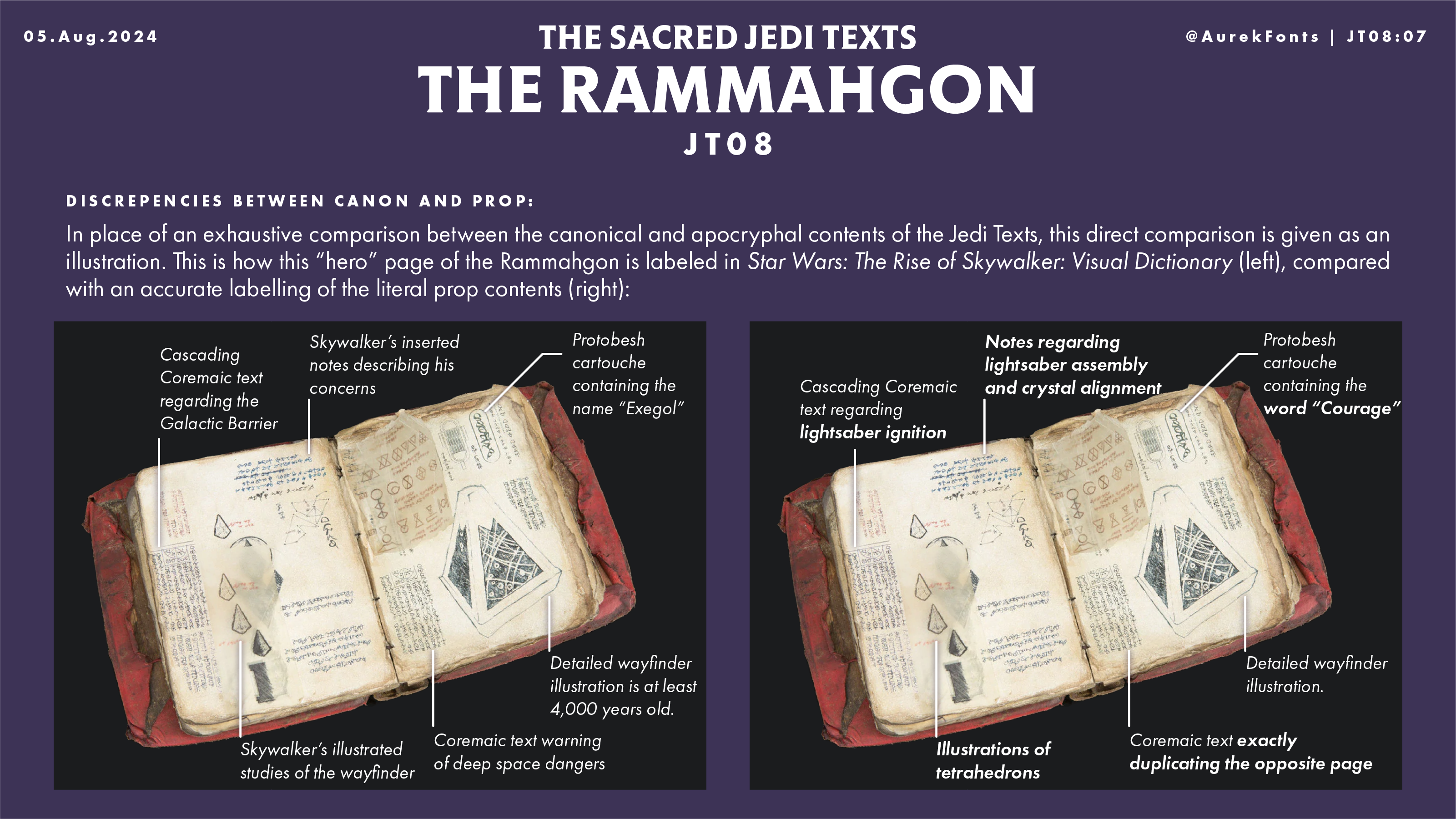
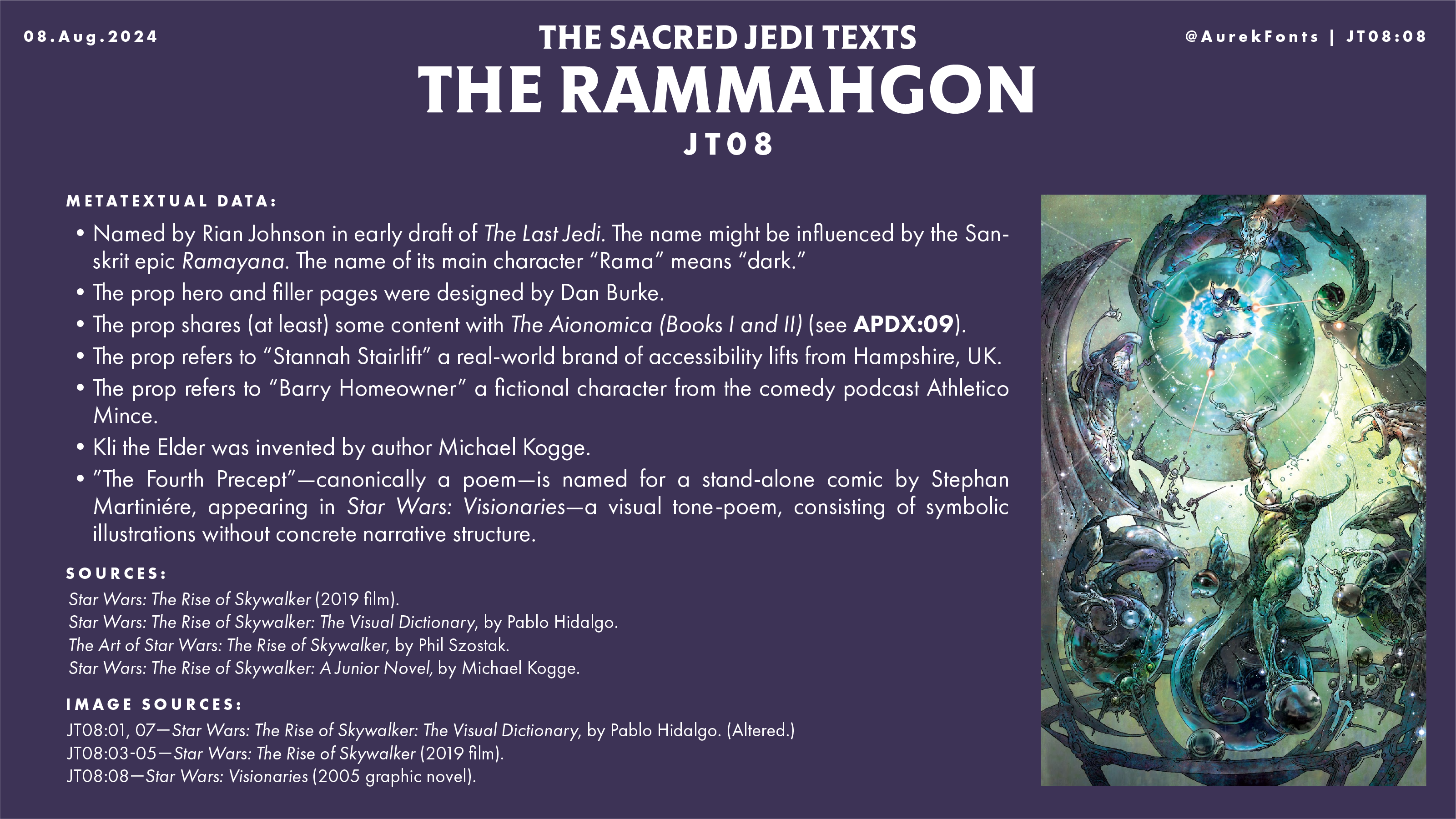
Jedi Texts without Positive ID:
JTX1
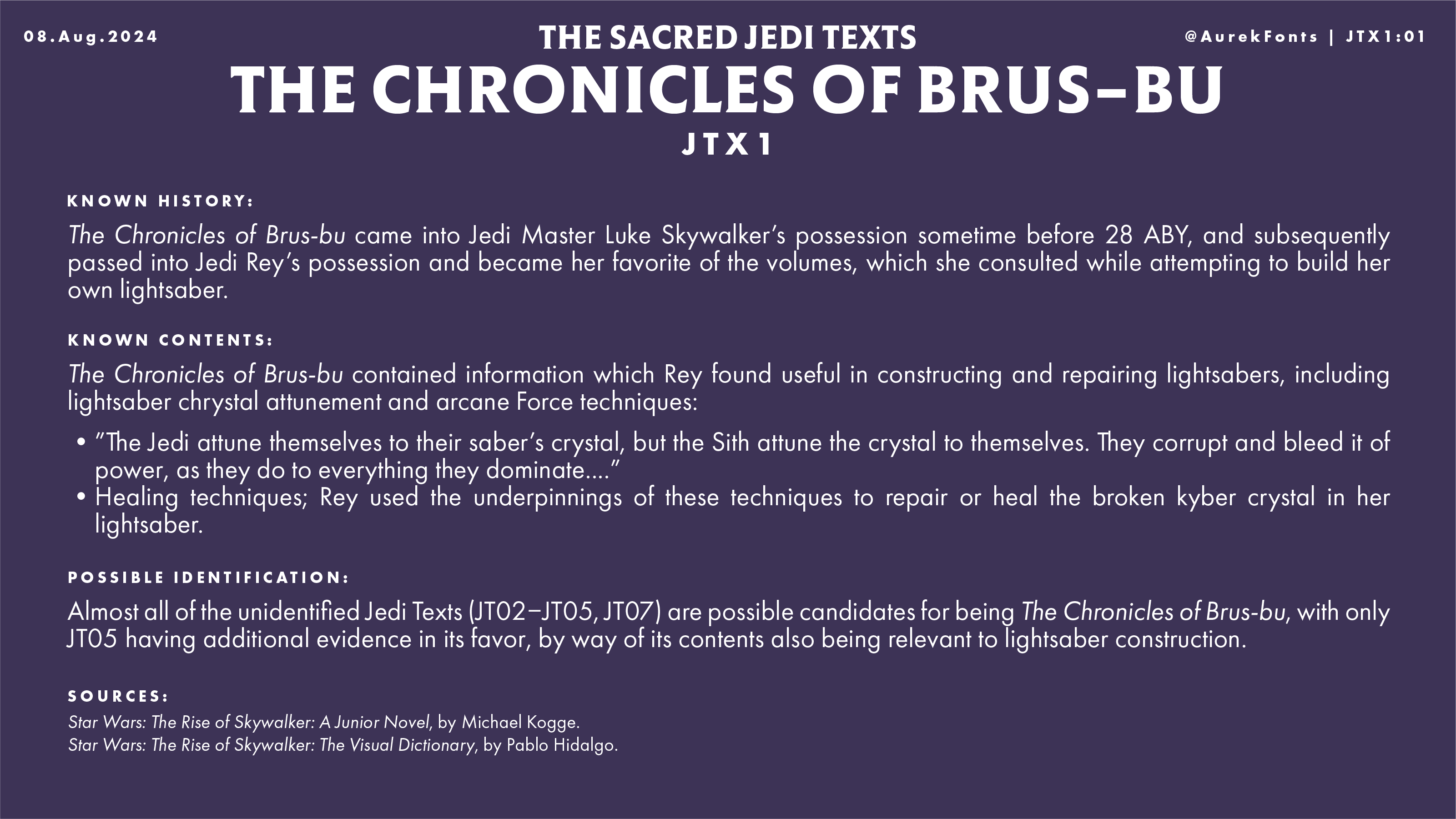
JTX2
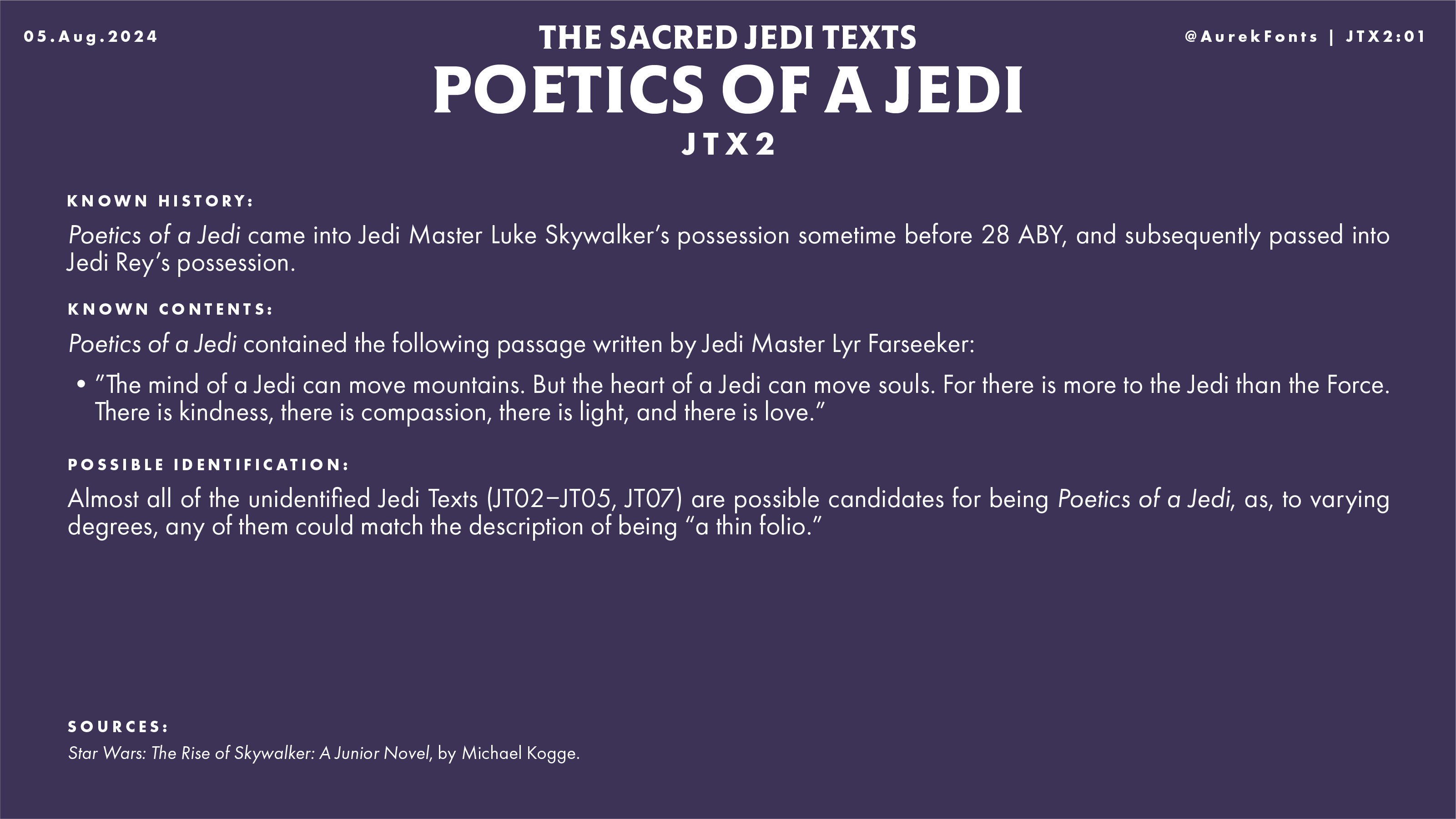
Appendices:
Appendix A: Languages
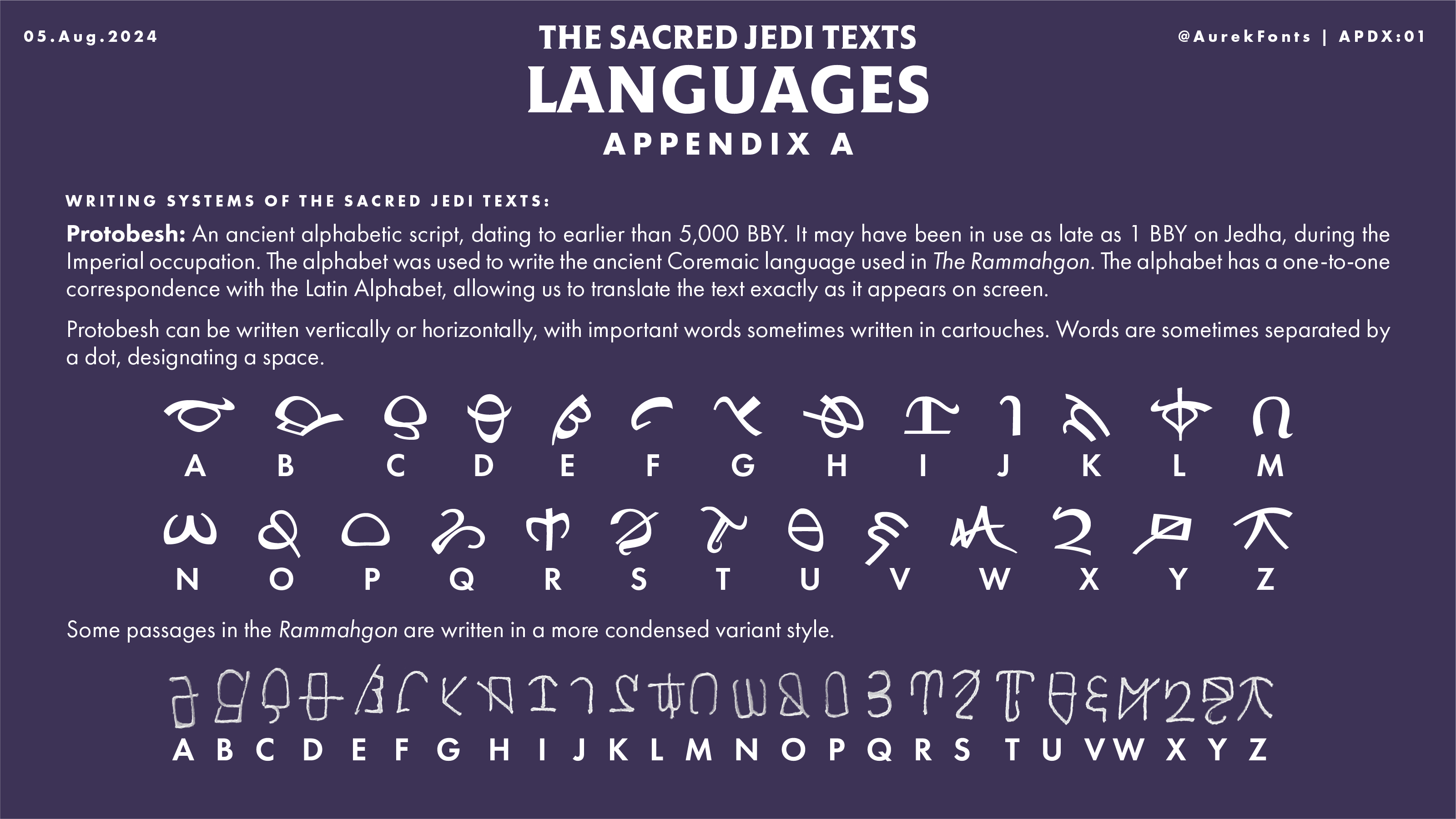
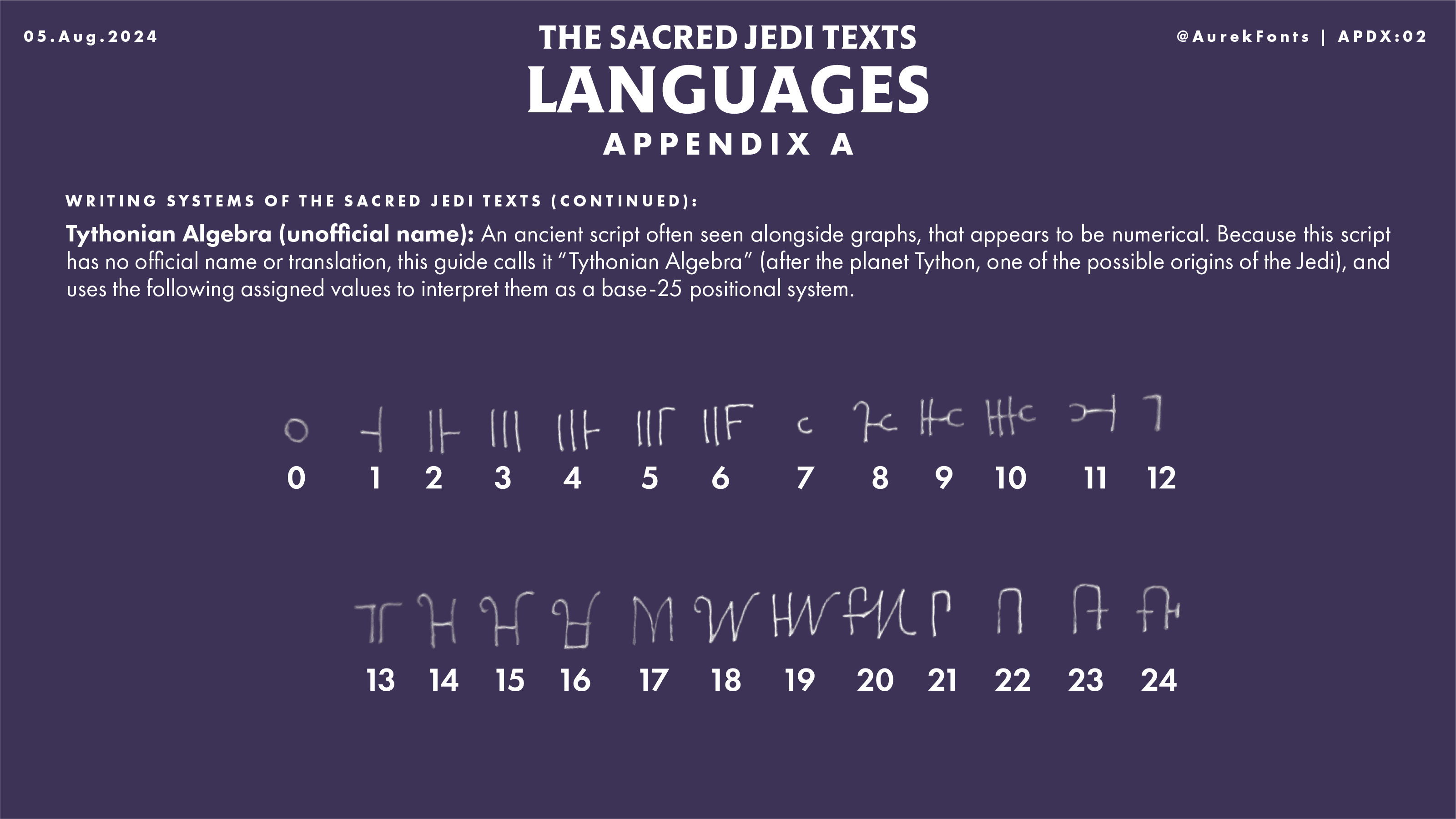
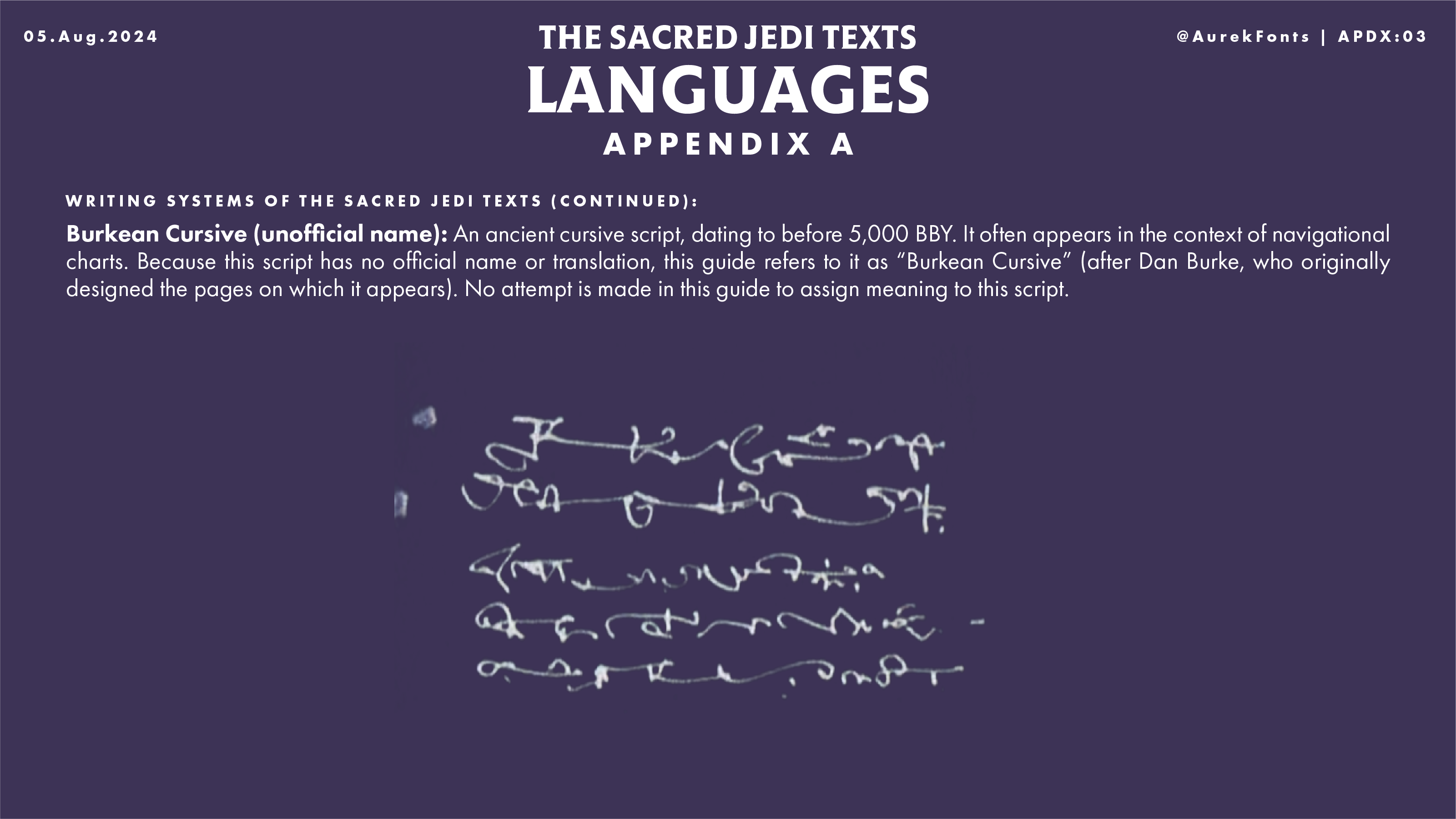
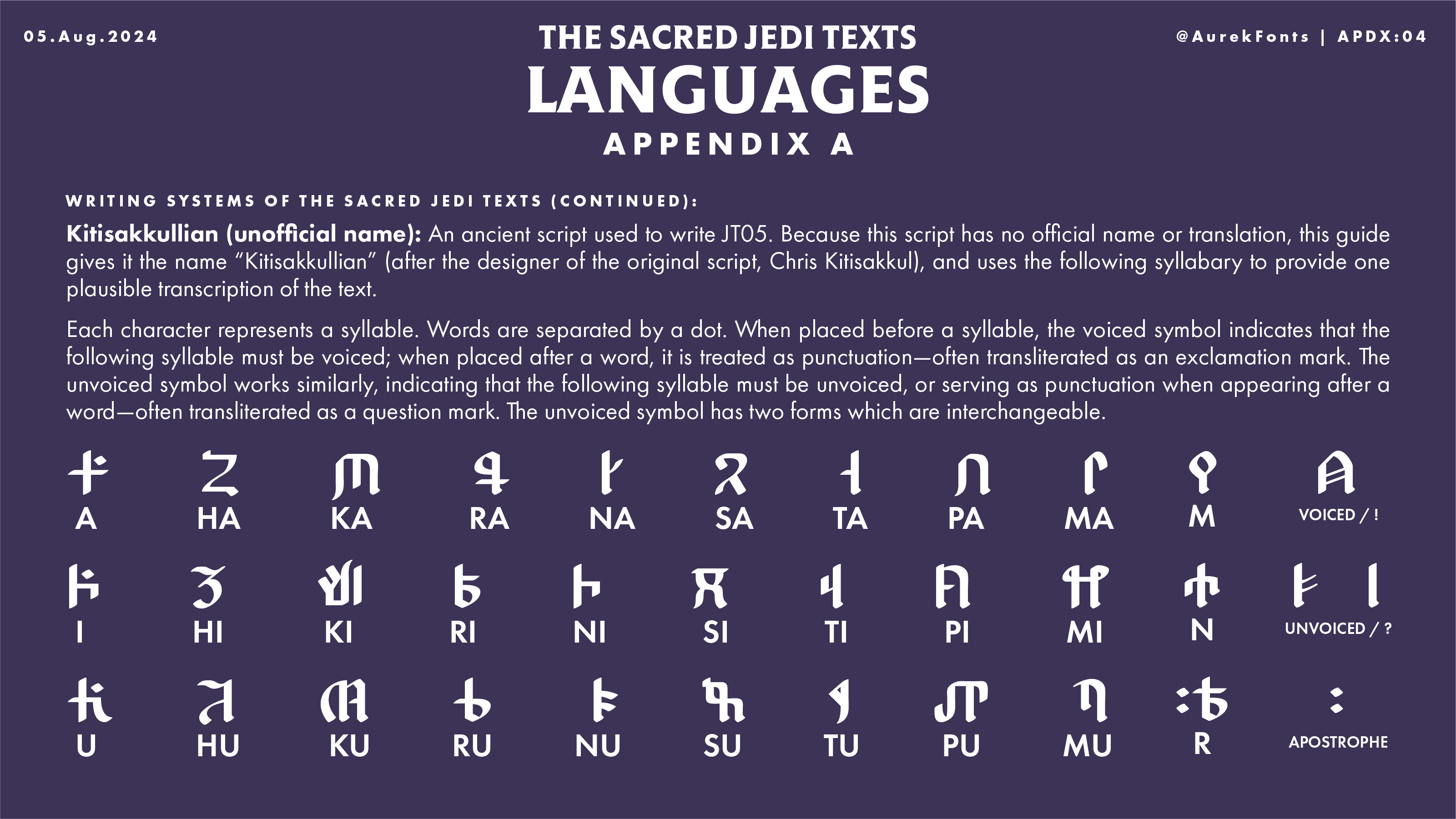

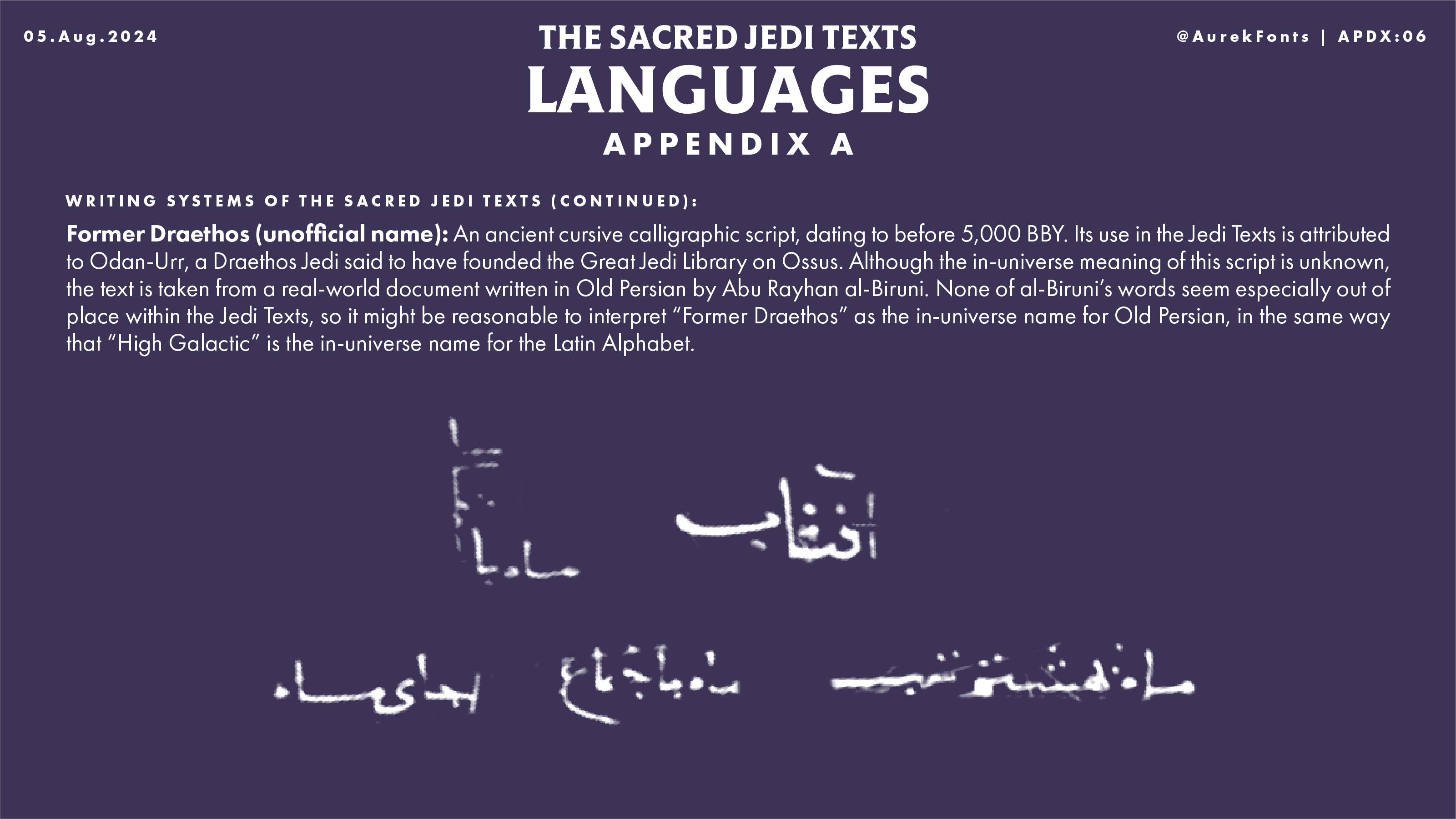
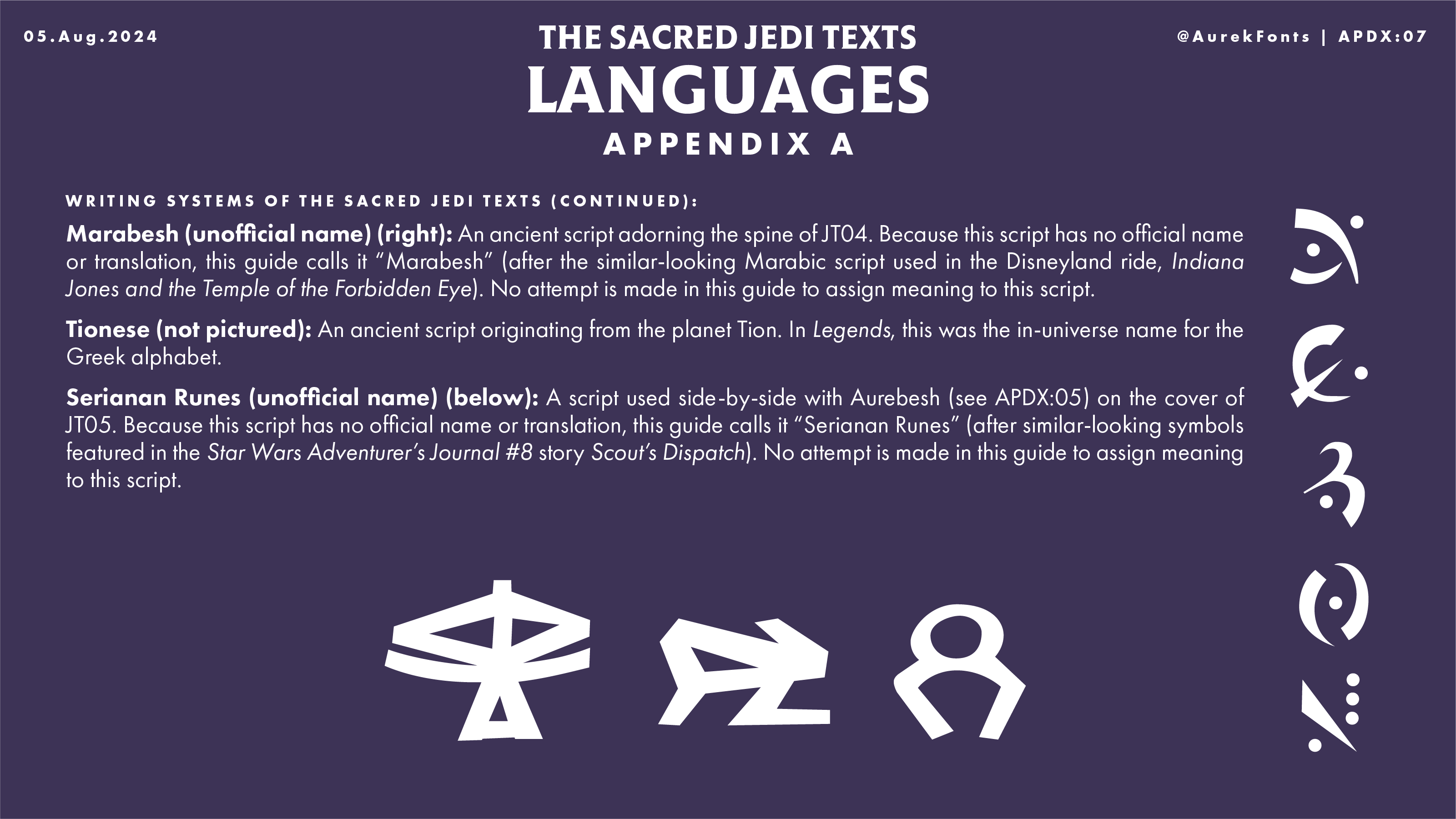

Appendix B: TROS Ur-Text
![The Sacred Jedi Texts. Appendix B: TROS Ur-Text; appendices, page 9.
Apocryphal (Literal Prop) Ur-Text:
Much of the translatable text found in The Rammahgon and Aionomica props from The Rise of Skywalker is repititious and incomplete.
By combining these repeated incomplete pieces, a coherent ur-text (a hypothetical original source) can be reasonably constructed. However the precise order and meaning may be harder to determine from the limited sources. The following is one possible ur-text for the Jedi Texts in The Rise of Skywalker:
'Once your lightsaber is assembled, crystal must be Force-aligned or the blade will not ignite.'
'In the second phase of each star cycle, the Jedi is offered the chance to align their being with the Force of their chosen crystal.'
'This is the final chance to Force-align. In star phase three, the entire crystal will be split in thirds.'
'[...] although common is often and easily misaligned. Split pieces can no longer be used to channel the Force. Failed pieces are highly volatile and therefore illegal to trade. Pieces are often traded amongst the smugglers and blackmarketeers as a power source.'
'Ignition process: The crystal begins to glow once the crystal is correctly aligned. Stability is critical. Crystal fits into crystal clamp. At this stage, the crystal is most volatile.'
'The Force is strongest. The Force flows freely. The Force is all.' The Sacred Jedi Texts. Appendix B: TROS Ur-Text; appendices, page 9. Apocryphal (Literal Prop) Ur-Text: Much of the translatable text found in The Rammahgon and Aionomica props from The Rise of Skywalker is repititious and incomplete. By combining these repeated incomplete pieces, a coherent ur-text (a hypothetical original source) can be reasonably constructed. However the precise order and meaning may be harder to determine from the limited sources. The following is one possible ur-text for the Jedi Texts in The Rise of Skywalker: 'Once your lightsaber is assembled, crystal must be Force-aligned or the blade will not ignite.' 'In the second phase of each star cycle, the Jedi is offered the chance to align their being with the Force of their chosen crystal.' 'This is the final chance to Force-align. In star phase three, the entire crystal will be split in thirds.' '[...] although common is often and easily misaligned. Split pieces can no longer be used to channel the Force. Failed pieces are highly volatile and therefore illegal to trade. Pieces are often traded amongst the smugglers and blackmarketeers as a power source.' 'Ignition process: The crystal begins to glow once the crystal is correctly aligned. Stability is critical. Crystal fits into crystal clamp. At this stage, the crystal is most volatile.' 'The Force is strongest. The Force flows freely. The Force is all.'](./src/GuideToSacredJediTexts/APDX/APDX-09.png)
Appendix C: Other Religious Texts
![The Sacred Jedi Texts. Appendix C: Other Religious Texts; appendices, page 10.
Translating Other Religious Texts:
While Luke's and Rey's library of texts are sometimes referred to as 'The Sacred Jedi Texts,' they are certainly not the only Jedio-Sithic religious writings available for translation and corroboration.
The Sith Dagger of Ochi of Bestoon: Inscribed with McQuarrie runes in the Sith language of ur-Kittât sometime between 4 and 28 ABY with the coordinates of Darth Sidious's Sith Wayfinder, a navigational tool necessary to find the location of the Sith world of Exegol:
Canonical translation: 'The Emperor's Wayfinder is in the Imperial vault at delta 3-6, transient 9-3-6 bearing 3-2, on a moon in the Endor system. From the Southern shore, only this blade tells.'
Apocryphal transliteration: [Excluded so as not to clutter the alt-text. It is a fairly random meaningless string of letters.]
(An accompanying photograph of the Sith dagger: It has a leather-wrapped handle; the hilt and blade are made of silvery metal; the blade is symmetrical, with irregular in-cuts midway down the length of the blade; the surface of the blade is covered in dense rectanglar runes.)
Obsidian Sith Temple inscription: The desk of Dryden Vos is held up by a slab of obsidian plundered from a Sith temple, and engraved with 'hierogrlyphs' representing warding spells. The text is rendered in a variation of Aurebesh known as Domabesh, and can give the following direct translation:
Apocryphal content (literal prop translation): 'Our temple / honouring / Sith Lord / Exar Kun.'
(A photograph of Dryden Vos's desk: the top and base of the desk are made of shining gold-colored metal, with insets and grooves; the table is held up by a large, roughly-hewn, pointed stone slab, which impales the desktop by several inches; the front surface of the stone is smooth, and covered in vertically written Domabesh runes and circular decorations.)
Image sources:
Star Wars: The Rise of Skywalker: The Visual Dictionary, by Pablo Hidalgo. (Altered.)
Solo: A Star Wars Story: The Official Guide, by Pablo Hidalgo. (Altered.) The Sacred Jedi Texts. Appendix C: Other Religious Texts; appendices, page 10. Translating Other Religious Texts: While Luke's and Rey's library of texts are sometimes referred to as 'The Sacred Jedi Texts,' they are certainly not the only Jedio-Sithic religious writings available for translation and corroboration. The Sith Dagger of Ochi of Bestoon: Inscribed with McQuarrie runes in the Sith language of ur-Kittât sometime between 4 and 28 ABY with the coordinates of Darth Sidious's Sith Wayfinder, a navigational tool necessary to find the location of the Sith world of Exegol: Canonical translation: 'The Emperor's Wayfinder is in the Imperial vault at delta 3-6, transient 9-3-6 bearing 3-2, on a moon in the Endor system. From the Southern shore, only this blade tells.' Apocryphal transliteration: [Excluded so as not to clutter the alt-text. It is a fairly random meaningless string of letters.] [An accompanying photograph of the Sith dagger: It has a leather-wrapped handle; the hilt and blade are made of silvery metal; the blade is symmetrical, with irregular in-cuts midway down the length of the blade; the surface of the blade is covered in dense rectanglar runes.] Obsidian Sith Temple inscription: The desk of Dryden Vos is held up by a slab of obsidian plundered from a Sith temple, and engraved with 'hierogrlyphs' representing warding spells. The text is rendered in a variation of Aurebesh known as Domabesh, and can give the following direct translation: Apocryphal content (literal prop translation): 'Our temple / honouring / Sith Lord / Exar Kun.' [A photograph of Dryden Vos's desk: the top and base of the desk are made of shining gold-colored metal, with insets and grooves; the table is held up by a large, roughly-hewn, pointed stone slab, which impales the desktop by several inches; the front surface of the stone is smooth, and covered in vertically written Domabesh runes and circular decorations.] Image sources: Star Wars: The Rise of Skywalker: The Visual Dictionary, by Pablo Hidalgo. (Altered.) Solo: A Star Wars Story: The Official Guide, by Pablo Hidalgo. (Altered.)](./src/GuideToSacredJediTexts/APDX/APDX-10.png)
![The Sacred Jedi Texts. Appendix C: Other Religious Texts; appendices, page 11.
Translating Other Religious Texts (continued):
Engraved Sacred Kyber: An inscription found on a Kyber crystal, stolen from the Kyber Temple of NiJedha, was written in Protobesh. It is unclear how old the inscription is:
Apocryphal content (literal prop translation): '[Trus]t / in the / Force'.
(Accompanying screenshot from Rogue One of the crystal in question: The crystal is mostly clear and transparent; it is attached to an open slide-out frame of a cylindrical metal cylinder; the crystal is as big as an adult human's arm; someone's red robe falls across the frame to the left; in the surface of the crystal, words are carved vertically in Protobesh, broken up into 3 cartouches.)
Image sources:
Rogue One: A Star Wars Story, (2016 film). The Sacred Jedi Texts. Appendix C: Other Religious Texts; appendices, page 11. Translating Other Religious Texts (continued): Engraved Sacred Kyber: An inscription found on a Kyber crystal, stolen from the Kyber Temple of NiJedha, was written in Protobesh. It is unclear how old the inscription is: Apocryphal content (literal prop translation): '[Trus]t / in the / Force'. (Accompanying screenshot from Rogue One of the crystal in question: The crystal is mostly clear and transparent; it is attached to an open slide-out frame of a cylindrical metal cylinder; the crystal is as big as an adult human's arm; someone's red robe falls across the frame to the left; in the surface of the crystal, words are carved vertically in Protobesh, broken up into 3 cartouches.) Image sources: Rogue One: A Star Wars Story, (2016 film).](./src/GuideToSacredJediTexts/APDX/APDX-11.png)
